




































Electric cooperative leaders from Mississippi went to Washington, D.C., in April for the National Rural Electric Cooperative Association’s (NRECA) Legislative Conference to engage members of Congress and urge policymakers to take action to help meet the growing demand for electricity.
“The Legislative Conference allows co-ops to speak to policymakers with one voice on issues that a ect us and our local communities,” NRECA CEO Jim Matheson said. “And while that is important every year, it is especially important at the start of a new Congress and a new administration.”
Mississippi co-op leaders met with Senators Roger Wicker and Cindy-Hyde-Smith as well as Congressmen Mike Ezell, Bennie G. Thompson, Michael Guest, and Trent Kelly to discuss pending legislation and regulatory reform.
“Even in today’s modern age of advocacy, there is still no more powerful tool than a good relationship and a face-to-face meeting with a policymaker,” said Hill Thomas, NRECA’s vice president of legislative a airs. “These have always been electric cooperative strong suits. Legislative Conference is the time to put that engagement to work.”

Over the next 10 years, winter peak demand is expected to rise about 18%, according to the North American Electric Reliability Corp.’s most recent Longterm Reliability Assessment.
NRECA members from all over the country urged Congress to pass additional reforms to environmental permitting that speeds up the process for co-ops to obtain federal approval to build crucial infrastructure projects. Co-op leaders want the legislation to include litigation reform that places reasonable limits on lawsuits seeking to block projects that have already received permits.

The Electric Cooperatives of Mississippi (ECM) and three local electric cooperatives took home 2025 Spotlight on Excellence Awards this year.
The awards are sponsored by the National Rural Electric Cooperative Association (NRECA) and the Council of Rural Electric Communicators. The awards shine a light on remarkable talent and innovation by recognizing a body of outstanding work produced by electric cooperative communication and marketing professionals from across the country.
ECM’s Legislative Roster App earned the top honor — gold — in the “Most Innovative Use of Digital Engagement” category.
The app allows users to find their statewide elected o cials as well as their state senators and representatives in seconds. Besides profiles and maps for lawmakers and their districts, users can find out which legislators are on the Seante and House committees and follow the progress of proposed bills through each session.
Cooperative Energy, a generation and transmission cooperative, won a gold award in the “Best Wild Card” category for their Cooperative Energy SPARK Award.
Dixie Electric won a first-place gold award in the “Best Short Form Video (Two Minutes or Less)” category for their piece, “Silent Strength: The Unsung Heroes of Power.”
Coast Electric won a silver award in the “Most Innovative Use of Digital Engagement” category for their piece, “Welcome to the Neighborhood.”
In other award news, ECM Vice President of Communications Lydia Walters won the Dave D’Avanzo Communications Leadership Award in May.
The Pioneer Utility Resources award honors co-op communicators known for giving, helping, and lifting others up in their careers in the cooperative world.
The peer-nominated award celebrates quiet leaders in the industry who make work and communities better in meaningful ways.
Congratulations to all the winners!



“Improving the quality of life for all those we touch.”
Now that summer is in full swing, like many of you, I welcome more opportunities to be outdoors and enjoy the warmer weather. Summertime brings many of my favorite activities like cooking out with family and friends, afternoons on the water and simply slowing down a bit to enjoy life.
But summer months also make conditions right for dangerous storms. Tropical weather experts predict that the 2025 Atlantic hurricane season will result in 21 named storms, including nine hurricanes. Of the storms projected to reach hurricane strength, three to five are predicted to become major hurricanes (Category 3 or higher storms that have maximum sustained winds of 111 mph or greater). And while we are several hours inland, we are often the recipient of spino storms associated with these hurricanes.
These potential weather events can cause destruction to our electrical system, but I want you to know that 4-County Electric Power Association crews are ready to respond should power outages occur in our area.
When major storms knock out power, our line crews take all necessary precautions before they get to work on any downed lines. I would encourage you to also practice safety and preparedness to protect your family during major storms and outages.
The Federal Emergency Management Agency recommends the items below as a starting point for storm and disaster preparedness, but you can visit www.ready.gov for additional resources.
• Stock your pantry with a three-day supply of non-perishable food, such as canned goods, energy bars, peanut butter, powdered milk, instant co ee, water and other essentials (i.e., diapers and toiletries).
• Confirm that you have adequate sanitation and hygiene supplies including towelettes, soap and hand sanitizer.
• Ensure your First Aid kit is stocked with pain relievers, bandages and other medical essentials, and make sure your prescriptions are current.
• Set aside basic household items you will need, including flashlights, batteries, a manual can opener and portable, batterypowered radio or TV.
• Organize emergency supplies so they are easily accessible in one location.
In the event of a prolonged power outage, turn o major appliances, TVs, computers and other sensitive electronics. This will help avert damage from a power surge and will also help prevent overloading the circuits during power restoration. That said, do leave one light on so you will know when power is restored.
Listen to local news or a NOAA Weather Radio for storm and emergency information, and check 4-County’s Facebook page or website for power restoration updates. You can also download our mobile app to report outages. To use the mobile web app, browse to 4county.org from your iOS or Android device. Then click on the “Pay Bill” or “View My Usage” link on the home page. To download the mobile app for your phone or tablet, please see the next section (How do I get the Mobile App for my device?). Once you’ve installed the mobile app on your device, you’ll also have the ability to receive push notifications and view a map of our o ces and payment locations.
After the storm, avoid downed power lines and walking through flooded areas where power lines could be submerged. Allow ample room for 4-County crews to safely perform their jobs, including on your property.
I hope we don’t experience severe storms this summer, but we can never predict Mother Nature’s plans. At 4-County, we recommend that you act today because there is power in planning. From our co-op family to yours, we hope you have a safe and wonderful summer.

by Brian Clark
CEO/General Manager
When a major outage occurs, our crews restore service to the greatest number of people in the shortest time possibleuntil everyone has power.

1

2

3

High Voltage Transmission Lines
These lines carry large amounts of electricity. They rarely fail but must be repaired first.
Distribution Substations Crews inspect substations, which can serve thousands of people.
Main
Distribution Lines
Main lines serve essential facilities like hospitals and larger communities.
Individual Homes and Businesses After main line repairs are complete, we repair lines that serve individual homes and businesses. 4



Longtime 4-County employees Anthony Miller and Joe Miller retired recently after serving the cooperative for a combined 89 years.
For most of 4-County’s membership, the Miller brothers have been a co-op mainstay and a frequent face of the cooperative.
4-County CEO Brian Clark said the duo has been instrumental in the co-op’s success story. Anthony, who retired as 4-County operations manager, and Joe, who retired as 4-County safety, training, and loss prevention coordinator, described 4-County as a great place to work and encouraged employees to support each other. They received a framed certificate of appreciation, a statue of a lineman, and other gifts.
Anthony’s career began as a laborer. He then worked in mechanical roles before becoming a groundman. He joined the apprentice lineman program and became a journeyman lineman in 1986. Anthony had several foreman positions, served as job, safety, and training coordinator, and later became district manager, (then, advancing to his last position as operations manager).
Joe’s career also began as a laborer. He then served as a groundman, before beginning the apprentice lineman program. He became a journeyman lineman in 1988. He served in a crew leader position, (then, advancing to his final co-op job as job, safety, and training coordinator).
Employees celebrated the duo’s years of service in a ceremony at the 4-County Corporate Center. About 100 employees attended the event.
















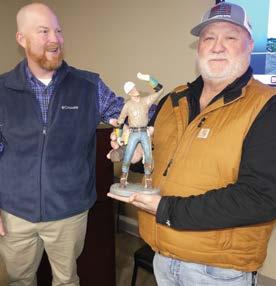





Wind, rain, and hail blew through the 4-County Electric Power Association system in May. At least three storm systems swept through, leaving downed lines, broken poles and outages in their wake. 4-County crews responded, accordingly. See associated photos.
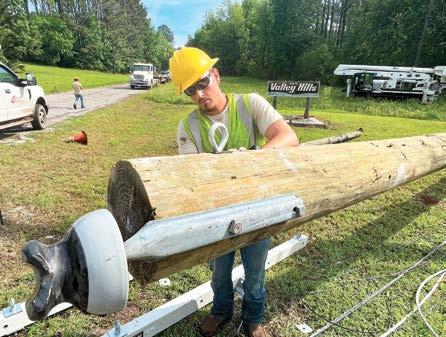
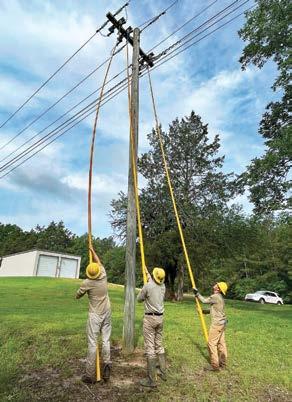

4-County o cials tipped their hard hats to local law enforcement personnel recently at a fish fry held at the co-op’s corporate center o ce.
CEO Brian Clark said 4-County often works with law enforcement throughout the co-op’s nine-county service area, and the interactions are a true partnership of cooperation. “During emergency response weather situations, we are often at the same place/same time. Area law enforcement is always supportive of our e orts to keep the lights on. We appreciate them and are happy to support them through our 4-County Foundation and events like this,” Clark said of the fish fry, which drew about 100 area law enforcement personnel. Co-op o cials hope to make the fish fry an annual event.











What are some energy e ciency upgrades I should consider when building a new house?





Prioritizing energy e ciency when building a new home can create future savings and make living more comfortable. It might cost a little more upfront but will pay o in the long run.



Let’s explore two approaches: Following an energy e ciency certification plan or adding energy e cient designs and equipment to your construction project.
There are several e ciency certifications available for newconstruction homes that may qualify for discounted homeowner’s insurance, tax credits, and other incentives.
Leadership in Energy and Environmental Design (LEED) certification ensures the home uses less energy while prioritizing sustainable resources and healthy indoor air quality. LEED-certified homes use 20% to 30% less energy than the average home — with some homes saving up to 60% — and can cost the same as nonLEED homes with proper planning, according to the U.S. Green Building Council.
Passive House certification requires the home to be so e cient it needs little to no heating and cooling equipment while remaining comfortable for its occupants. To achieve up to 90% less energy use than the average home, the certification focuses on maximizing the e ciency of the building envelope — all components that separate the indoors from the outdoors — including proper insulation levels, air sealing and high-e ciency windows.

ENERGY STAR® NextGen Certification for New Homes recognizes houses that are 20% more e cient than the average home and help reduce greenhouse gas emissions by 40% to 80%.
Although various certifications are available, you don’t have to follow a set guide, according to Ronnie Vernon, lead marketing specialist for 4-County. Consider adding these energy e ciency principles to your new home build.
“Advanced framing techniques maximize the amount of insulated area and save on material costs in wood-framed homes,” Vernon said. This technique can save up to $500 for a 1,200-square-foot home and $1,000 for a 2,400-square-foot home on material costs, between 3% to 5% on labor costs and up to 5% on annual heating and cooling costs, according to the U.S. Department of Energy. “Choose a contractor who is familiar with these techniques, and check with your local building o cials to ensure compliance with local codes,” Vernon added.


The importance of a home’s orientation is often overlooked. According to the International Association of Certified Home Inspectors, homes oriented to the path of the sun use less energy for heating and cooling to reduce energy bills and improve comfort.

If you are building or buying a new home that doesn’t allow options for orientation or framing, you might be able to request higher insulation levels in the attic. Increasing the insulation levels likely won’t cost much more for materials and labor, but it can help you use less energy and save money in the long run.
Heating and cooling equipment should be properly sized using energy modeling tools that calculate the home’s heating and cooling needs, Vernon advised. “Investing in a more e cient building envelope that is well insulated and air sealed can reduce the home’s heating and cooling load, making it possible to have a smaller, less expensive heating and cooling system. This saves money on equipment costs and lowers energy use.”
Optimizing the e ciency of a new home requires a whole-house approach. Analyze all systems and how they work together to ensure maximum e ciency for a safe and comfortable home.














































A tradition of dependable, hometown service since 1937

CARTHAGE: 601-267-5671 | PHILADELPHIA: 601-656-2601 | RANKIN: 601-829-1201 | SEBASTOPOL: 601-625-7422


















When outdoor temperatures soar, our electricity use increases. That’s because our air conditioners are running longer and more often to counteract sweltering outdoor temperatures. Factor in that we all tend to use electricity at the same times — in the morning and early evenings — and that equals a lot of strain on our electric grid.
At Central Electric Power Association, we work closely with Tennessee Valley Authority (TVA), our local generation and transmission (G&T) cooperative in resource and infrastructure planning to ensure you have the power you need whenever you flip a switch, but the electric grid is much larger than your local co-op and G&T.
In summer months, when even more electricity is being





used simultaneously across the country, it is possible for electricity demand to exceed supply, especially if a prolonged heat wave occurs. If this happens, which is rare, the grid operator for our region of the country may call on consumers to actively reduce their energy use or initiate rolling power outages to relieve pressure on the grid. Central Electric will always keep you informed about situations like this.
We work proactively with our G&T to create a resilient portion of the grid and ensure electric reliability in extreme weather, including regular system maintenance, grid modernization e orts, and disaster response planning, but it takes everyone to keep the grid reliable.

To help keep the air conditioner running for you, your family and neighbors, here are a few things you can do to relieve pressure on the grid during times of extreme summer heat:
• Select the highest comfortable thermostat setting and turn it up several degrees whenever possible. Your cooling system must run longer to make up the di erence between the thermostat temp and the outdoor temp.
– Pro tip: Seal air leaks around windows and exterior doors with caulk and weatherstripping. Air leaks and drafts force your cooling system to work harder than necessary.
• Use ceiling fans to make yourself feel a few degrees cooler. Remember, ceiling fans cool people (not rooms), so turn them o in unoccupied rooms.
– Pro tip: During summer months, set ceiling fan blades to rotate counterclockwise, which pushes cool air down for a windchill e ect.

• Run major appliances, such as dishwashers, ovens, and dryers, during o -peak hours when the demand for electricity is lower.
– Pro tip: Start the dishwasher before you go to bed.
• Close blinds, curtains and shades during the hottest part of the day to block unwanted heat gain from sunlight.
– Pro tip: Consider blackout curtains with thermal backing or reflective lining to block heat and light.
• Use smaller appliances, such as slow cookers, air fryers, and toaster ovens, to cook meals.
– Pro tip: Studies have shown that air fryers use about half the amount of electricity than a full-sized oven. Air fryers are smaller and use focused heat, which results in faster cooking times, less heat output, and lower energy use.
As we face the challenges posed by soaring summer temperatures, understanding the impact on energy demand is crucial for maintaining a reliable power supply. By adopting energy conservation practices during periods of extreme heat, not only can you save money on your electric bills, but you can also contribute to the resilience of the grid, keeping our local community cool and connected.













QWhat are some energy e ciency upgrades I should consider when building a new house?



APrioritizing energy e ciency when building a new home can create future savings and make living more comfortable. It might cost a little more upfront but will pay o in the long run.


by Miranda Boutelle

Let’s explore two approaches: Following an energy e ciency certification plan or adding energy e cient designs and equipment to your construction project.
There are several e ciency certifications available for new-construction homes that may qualify for discounted homeowner’s insurance, tax credits, and other incentives.
Leadership in Energy and Environmental Design (LEED) certification ensures the home uses less energy while prioritizing sustainable resources and healthy indoor air quality. LEED-certified homes use 20% to 30% less energy than the average home — with some homes saving up to 60% — and can cost the same as non-LEED homes with proper planning, according to the U.S. Green Building Council.


Passive House certification requires the home to be so e cient it needs little to no heating and cooling equipment while remaining comfortable for its occupants. To achieve up to 90% less energy use than the average home, the certification focuses on maximizing the e ciency of the building envelope — all components that separate the indoors from the outdoors — including proper insulation levels, air sealing and high-e ciency windows.
ENERGY STAR® NextGen Certification for New Homes recognizes houses that are 20% more e cient than the average home and help reduce greenhouse gas emissions by 40% to 80%.
Although various certifications are available, you don’t have to follow a set guide. Consider adding these energy e ciency principles to your new home build.





Advanced framing techniques maximize the amount of insulated area and save on material costs in woodframed homes. This technique can save up to $500 for a 1,200-square-foot home and $1,000 for a 2,400square-foot home on material costs, between 3% to 5% on labor costs and up to 5% on annual heating and cooling costs, according to the U.S. Department of Energy. Choose a contractor who is familiar with these techniques, and check with your local building o cials to ensure compliance with local codes.
The importance of a home’s orientation is often overlooked. According to the International Association of Certified Home Inspectors, homes oriented to the path of the sun use less energy for heating and cooling to reduce energy bills and improve comfort.
Advanced framing techniques maximize the amount of insulated area and save on material costs in wood-framed homes. This technique can save up to $500 for a 1,200-square-foot home and $1,000 for a 2,400-square-foot home on material costs.
If you are building or buying a new home that doesn’t allow options for orientation or framing, you might be able to request higher insulation levels in the attic. Increasing the insulation levels likely won’t cost much more for materials and labor, but it can help you use less energy and save money in the long run.
Heating and cooling equipment should be properly sized using energy modeling tools that calculate the home’s heating and cooling needs. Investing in a more e cient building envelope that is well insulated and air sealed can reduce the home’s heating and cooling load, making it possible to have a smaller, less expensive heating and cooling system. This saves money on equipment costs and lowers energy use.
Optimizing the e ciency of a new home requires a whole-house approach. Analyze all systems and how they work together to ensure maximum e ciency for a safe and comfortable home.
Miranda Boutelle is the chief operating o cer at E ciency Services Group in Oregon, a cooperatively owned energy e ciency company.

The Electric Cooperatives of Mississippi Foundation was created by the state’s electric cooperatives in 2005. In an e ort to give back to the communities they serve, the Foundation provides scholarships for post-secondary and vocational education to accredited institutions for qualifying high school seniors. For the fall of 2025, the Foundation awarded scholarships to dependents of employees of participating electric cooperatives. Four Central Electric employee’s children who are entering college this fall were awarded the ECM Foundation Scholarships. Central Electric wants to congratulate each recipient on receiving this scholarship.



Union Public School District
Suzanne Burnett is the daughter of Danny and Tammy Burnett. She is a graduate of Union Public School District. Suzanne enjoys painting and reading. She plans to attend East Central Community College and Mississippi State University to pursue a degree in early childhood education.


Union High School
Abbie Louise Scarbrough is the daughter of Fred and Alisa Scarbrough. She is a graduate of Union High School. In high school, Abbie was a member of the high school band and softball team. She also enjoys hunting and fishing. Abbie plans to attend East Central Community College lineman school along with pursuing a welding degree.

ELECTED BOARD OF DIRECTORS




Lake High School
John Michael Duncan is the son of Michael and Nyka Duncan. He is a graduate of Lake High School. John Michael enjoys fishing, golf, and hunting. He plans to attend East Central Community College and Mississippi State University to pursue a degree in computer engineering.


Grayson White is the daughter of Michael and Cherie Brooks and Michael White. She is a graduate of Germantown High School. Grayson plans to attend Holmes Community College and then the University of Mississippi Medical Center to pursue a bachelor of science degree in nursing.


The elected board of directors are Jackie Harpole, Leake County; Andrew Windham, Neshoba County; Kenneth Hagan, Newton County; and Phillip Crosby, minority member at large.


























by Qua’Shara Monix
After nearly four decades of dedicated service, Bryan “Bubba” Glover is retiring from Coahoma Electric Power Association. Bubba began his career with the company in September 1986, starting as a lineman, a role in which he worked tirelessly for two years — inspecting poles, reading meters five days a week, and investigating current diversion. Bubba was then promoted to warehouse supervisor as well as purchasing manager where he developed a purchasing strategy, reviewed and processed purchase orders, maintained equipment ordered, and received and most importantly built and preserved quality relationships with vendors. His commitment to safety, service, and excellence has made a lasting impact on both the company and the community.
Before joining Coahoma Electric, Bubba served his country with honor as a member of the U.S. Army and Mississippi Army National Guard from February 1978 until his retirement in December 1999, achieving the rank of E-6. He also gave back locally, serving as a volunteer firefighter for 10 years and coaching little league baseball, mentoring young athletes, and making a di erence in their lives.
Beyond his professional accomplishments, Bubba is a devoted family man. He and his lovely wife, Renee, have built a beautiful life together. He is the proud father of three sons: Ryan, Josh, and Caleb, and a loving grandfather to two grandchildren, John and Eleana.
Bubba’s presence will be greatly missed at Coahoma Electric. His work ethic, kindness, and sense of humor have left a lasting mark on everyone fortunate enough to work with him. While we’re sad to see him go, we are excited for this next chapter of his life and wish him a joyful, well-deserved retirement.
Thank you, Bubba, for 38 years of unwavering service. You’ve truly earned this next adventure.





































































by Qua’Shara Monix

























































• Father of six





























Jason doesn’t just fix vehicles — he probably built his first child’s crib out of spare alternators and duct tape. With six kids, Jason’s greatest talent isn’t just mechanical — it’s survival. His hobbies include hiding in the garage “looking for a wrench” and pretending he can’t hear the kids over the sound of a power drill.
(Office Manager) • Father of two
Bob runs the o ce with an iron spreadsheet and a strict “no glitter” policy. With two kids at home, he’s the calm in the storm — until someone uses Comic Sans in a company email. Bob’s kids say he’s the funniest dad ever, especially when he tries to use slang like “yeet” and “lit.” (Please stop, Bob.)
• Father of two
Mike reads meters and bedtime stories with equal precision. He’s also been known to fix a busted toy using only a multimeter and sheer willpower.
• Evan has four kids, which explains why he volunteers for every overtime shift.
• Raymond also has four kids and probably shares a group chat with Evan titled “How to stay at work a little longer.”
• James — another 4-kid club member — says linework is easier than helping with math homework.
• Ahmad has two kids and reports being shocked more by toddler tantrums than any electrical line.


























































































Father’s Day is a time to honor the men who gave us life, taught us how to ride a bike, and then promptly used that same bike as a makeshift tool rack. But here at Coahoma Electric Power Association, Father’s Day isn’t just a holiday — it’s a major power surge of dad jokes, unmatched tool knowledge, and a staggering number of children who probably make up half the local population. Let’s plug into some of the finest father-figures on this side of the power pole.







































the kids outnumber the kilowatts


















I tried to tell a joke about high voltage, but… It was just too shocking for some people.
These guys climb poles for a living and wrangle kids like it’s their second full-time job.
• Troy, with eight children, is basically operating his own school district at home. He’s not an apprentice lineman — he’s a dad wizard.
• Hunter, Mason, Cameron, and Austin Strider each have one child and are still in the “sleep is for the weak” stage of parenthood.
• Jack has two kids and just bought noise-canceling headphones. “For safety,” he claims. Sure, Jack.





































































Father of six
Father of two





























Jeff (Operations Manager)





































Elliott (Warehouse & Facilities Supervisor
/Apprentice Lineman) • Father of three
Elliott is a double-duty dad and double-duty worker. If you’ve ever seen a man change a diaper with one hand while wiring a panel with the other, you’ve seen Elliott.
Ken (Operations Supervisor, Tunica)
Ken is living proof that you can manage operations and six kids at once, though he sometimes shows up to meetings with a pacifier in one pocket and a juice box in the other.
Warren (Right-of-Way) • Father of six
Warren clears right-of-way at work and clears LEGOs o the living room floor at home. He says brush piles are nothing compared to laundry piles.
Je manages operations like a pro and has mastered the “dad nod”— a gesture of approval, understanding, and “please don’t break that.”
Clyde (Crew Leader) • Father of FIVE
Clyde’s house has more children than his crew truck has tools. His parenting style? Direct. E cient. Loud enough to be heard over a chainsaw.
Frank (IT Supervisor) • Father of two
Frank fixes computers, resets routers, and is the only dad in the o ce who can be both a tech genius and a master of “Have you tried turning it o and on again?” parenting.






















































































Father of two
Father of three
The grand total































Father of one newborn
Randy (Staking Technician)
Jerry (Warehouse & Facilities

























































Melvin (Right-of-Way) • Father of five
Melvin clears paths through forests at work and toy-strewn hallways at home. He’s built more forts out of couch cushions than tree limbs.
Let’s all take a moment to salute Hays, who is currently surviving on zero sleep, warmed-up co ee, and pure GPS-fueled adrenaline.
Dick teaches safety all day, but at home, his most-used phrase is “Don’t lick that!”—which is surprisingly applicable in both settings.
Randy drives stakes into the ground and makes decisions at home with the same precision. He once mapped out a grocery store trip with a plotter.
Supervisor, Coahoma) • Father of three
Jerry keeps the warehouse in order and his kids in line — though some say the warehouse is easier. No one’s ever tried to hide candy in a breaker box, after all.
By our highly scientific and definitely accurate calculations, the dads of Coahoma Electric Power Association are collectively responsible for 76 children—or approximately 25% of Mississippi’s future workforce. If there’s ever a statewide outage, don’t worry — Coahoma’s dads are already awake, already ca einated, and ready to fix it… after they finish a diaper change, a science project, and yelling “Who left the fridge open?!”
To the dads of Coahoma Electric Power Association — you power our lines, our lives, and about 14 different youth sports teams. Happy Father’s Day! May your grills be hot, your tools be organized, and your naps be uninterrupted (for at least 6 minutes).






















by Michael Leitman
Providing members with safe, reliable, and a ordable power is the mantra for electric cooperatives across the nation. Co-op members can see the work necessary to maintain reliable electricity at the local level, such as co-op lineworkers maintaining utility poles and wires and repairing them after major storms. At the regional and national levels, a diverse mix of power generation resources, transmission lines, and pipeline infrastructure are essential cornerstones of maintaining reliable electricity.
The U.S. electric grid has undergone major changes over the last decade. The share of electricity generated from coal plants has declined significantly, while the share from natural gas and intermittent wind and solar generation has grown. Fuel diversity means that your electricity is supplied by a variety of generation technologies, each with their own characteristics and performance capabilities over di erent weather and seasonal conditions.
Dispatchable technologies can be turned on and o as needed. Large steam generation plants (most commonly using coal or nuclear fuels) are generally considered “baseload,” meaning that they are designed to run e ciently 24/7 to serve as the base of the electricity mix. However, steam plants are less capable of ramping output up or down to meet the various peaks and dips as grid conditions change.
Natural gas is the most versatile fuel, powering large combinedcycle plants that can operate as baseload but are also more flexible ramping up and down. These capabilities are essential for meeting demand on the hottest and coldest days, and for balancing intermittent renewable energy sources, such as solar and wind.
Most hydroelectric power comes from generators inside large dams, which can be dispatched when needed — as long as there is enough water available. Cooperative Energy, a Mississippi generation and transmission cooperative, has several contracts to buy hydroelectric power from the Southeastern Power Administration.
Over the last decade, the share of electricity generated from wind and solar plants has increased dramatically. These beneficial, “no-fuel-required” plants can deliver low-cost electricity — but they only generate electricity when the wind blows and the sun shines. The production patterns of solar and wind technologies are complimentary to one another. Solar generates during the day and wind tends to generate more at night. Across seasons, wind output is typically higher during the colder months when there is less sunshine. Deployed together, wind and solar technologies can balance each other. Although there is a limited availability of wind power in Mississippi, there is a small amount that supplements power in the state from The Midcontinent Independent System Operation (MISO), a regional power reliability group that counts the state as a member.
















While battery energy storage technology is growing rapidly to allow some control of when renewable energy sources can be dispatched, natural gas plants remain the primary method for “firming” renewable generation resources.
Ultimately, our electric grid is most reliable when a wide range of technologies is available. When conditions lead to lower generation from one type of source, others can help compensate. When there is an imbalance, such as a major winter storm when electricity use skyrockets, grid operators are forced to rely on purposefully reducing demand and occasionally plan rolling blackouts to keep the grid operating.
While there is variation across regions in what types of power plants can be built based on weather and infrastructure, America’s electric cooperatives work diligently to ensure a diverse and reliable power supply for the communities they serve.

Our electric grid is most reliable when a wide range of technologies, including traditional and renewable energy sources, is available.























At Coast Electric, the consumers we serve are members and owners of our cooperative. We feel a responsibility to look out for our members – including informing them about scam attempts or potentially damaging investments. Please use these tips to keep your family safe and your finances secure.
• Do not ever share personal financial information with anyone who calls you and demands payment. Coast Electric will not call to demand payment, and we will not require a particular type of payment method. Members can pay their bills using any valid form of payment they wish.
• If you are ever in doubt, reach out to us. Scammers are using updated technology that can make it look like they are calling from any phone number – even ours – so if you ever feel like something isn’t quite right, hang up and give us a call, visit our website or come in to see us. Our member service representatives will be happy to help you.




We support our members who would like to install solar panels on their property. There are reputable companies that will help meet your needs, but we recommend that you do your research. We’ve heard reports recently that some companies are making false claims about the payback on your investment and about Coast Electric’s rates. Before you make a big investment, reach out to us. We have energy experts available to help you make the best decision for you and your family.
As your local co-op, we are your friends and neighbors. We are a not-for-profit organization that is owned by YOU, so it is in our best interest to look out for yours.
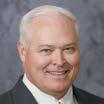
by Ron Barnes
President and CEO
Coast Electric wants you to reduce your energy use and see savings on your energy costs. Each month, you will have an opportunity to register to win a prize that will help you reduce the energy consumption in your home. Visit coastelectric.coop or scan the QR code to enter. It only takes a few seconds, and you could win a prize that helps you save!





























TO CONTACT COAST ELECTRIC:
You can report outages by:
• Using the CE on the Go mobile app.
Coast Electric’s business o ces will be closed Thursday, July 4, for Independence Day. Dispatchers will be on duty, and crews will be on call throughout the holiday weekend.
• Texting us at 228-338-4644 if you have a mobile number associated with your account.
• Reporting it online: https://outages.coastelectric.coop/


You can pay a bill by:


• We CANNOT take outage reports on our social media accounts or through email. Trying to report your outage in these ways does not put your outage into our system or report it to dispatchers or crews.

• Using the CE on the Go mobile app.
• Visiting a kiosk located at each of our o ces.
• Calling 877-769-2372 to use our automated payment system.




• Texting “Pay” to 352667 if you have a mobile number associated with your account.

For all after-hours inquiries, CoastConnect subscribers can chat with tech support on CoastConnect.com or call 877-969-3884 and speak to our 24/7 tech support team.
Economic development e orts in Pearl River County are poised for success with the completion of a specialized strategic plan and a recently awarded Cooperative Competes grant.
In late 2024, the Pearl River County economic development division initiated a Comprehensive Incentives Study with partners at VisionFirst Advisors. The study outcome will be a guidebook for o ering local incentives to economic development projects. Furthermore, the strategic plan process will foster education and commitment of local stakeholders on how to most e ectively and e ciently leverage incentive resources to encourage healthy economic growth.
Lindsay Ward, Pearl River County economic development director.
“The Cooperative Competes grant allows us to take a proactive approach in developing a clear, well-informed incentives strategy that will guide our economic development e orts for years to come. We appreciate the support of Cooperative Energy and Coast Electric in helping us strengthen our ability to attract and retain businesses that benefit our community.”

The strategic plan is made possible with funding support from partners like Coast Electric through the Cooperative Competes program. The $5,000 Cooperative Competes grant will help o set the costs of the strategy.

“Strategic planning is essential to ensuring Pearl River County remains competitive for new investment and job creation,” said
The Cooperative Competes initiative is aimed at increasing community competitiveness and encouraging economic growth. A component of the initiative allows economic development organizations to apply for grant funds to support industrial property, workforce, or community development e orts throughout Mississippi. These funds are provided jointly by Cooperative Energy’s 11 member distribution cooperatives, like Coast Electric.
For more information about Cooperative Competes visit cooperativeenergy.com/economic-development-cooperative-competes/..



Congratulations to the following local non-profit organizations that were awarded Operation Round Up grants after their applications were vetted by the Gulf Coast Community Foundation and reviewed and approved by members of Coast Electric’s Community Trust committee. Grants are awarded twice each year and are funded by Coast Electric members who choose to round up their bills to the nearest dollar amount each month.
This cycle, 17 grants in the amount of $140,830 were awarded to local, charitable organizations, including:
CASA of South Mississippi
Hancock County Food Pantry Inc.
Feeding the Gulf Coast
Backpack Buddies of Poplarville Inc.
Bethel Free Clinic
MS Gulf Coast Buddy Sports
Back Bay Mission
Mississippi Coding Academies
Kiwanis Club of Picayune
$9,600
$10,000
$10,000
$5,000
$5,000
$10,000
$5,000
$6,630
$10,000
Pearlington Impact Association
Gulf Coast Center for Nonviolence
Manna Ministries Inc.
Elijah’s Closet
Gateway Methodist Tootle Food Pantry
USM Research Foundation
Boy Scouts of America
Hancock County – Excel by 5
$10,000
$10,000
$10,000
$10,000
$10,000
$9,300
$5,300
$5,000
For information about Operation Round Up and the impact it has on our community, visit coastelectric.coop/my-community/operation-roundup/. Applications will be available for grants again in August.
The annual meeting of the members of Coast Electric Power Association will be held on Nov. 6, 2025. The following information is provided in accordance with association bylaws.
Committee on Nominations - It shall be the duty of the Board to appoint, no less than 120 days before the date of the meeting of the members at which directors are to be elected, a committee on nominations consisting of not less than 5 nor more than 11 members who shall be selected from di erent sections so as to insure equitable geographic representation. No existing Association employees, agents, o cers, directors or known candidates for director, or close relatives (as hereinafter defined) or members of the same household of existing Association employees, agents, o cers, directors or known candidates for director may serve on such committees. The committee shall receive and consider any suggestion as to nominees submitted by members of the Association. The committee shall meet at a time and physical or virtual location set by the Board of Directors. The committee shall prepare and post at the principal o ce of the Association at least 90 calendar days before the meeting a list of nominations for board members. The Secretary must mail with the notice of the meeting or separately a statement of the number of board members to be elected and the names and addresses of the candidates nominated by the committee on nominations. (b) Nominations by Petition. Any 25 members acting together may make other nominations by petition and the Secretary shall post such nominations at the same place where the list of nominations by the committee is posted provided same is filed with and approved by the Committee on Nominations at least 90 calendar days prior to the Annual Meeting. Any petition for nomination shall be submitted on a form designated and provided by the Association. The Association shall provide notice to the members of the application for candidacy to the board of directors by mail at least 150 days prior to the Annual Meeting. Each member signing such petition shall place thereon the date of signing, address, account number and service location of the member. Nominations made by petition, if any, received at least 120 days before the meeting shall be included on the o cial ballot, if filed and approved by the Committee on Nominations, although such nominations shall not be posted at the principal o ce of the Association. Nominations made by petition, if any, received by the Committee at least 7 calendar days prior to the meeting date and time, if filed and approved by the Committee, shall not be included on the o cial ballot but the candidate will qualify as a write-in candidate.





The Go To App for Parental Monitoring.
The Go-To App for Parental Monitoring.
Bark helps to:
Bark helps to:
→ Monitor texts, apps, social media and web searches: The advanced parental monitoring technology scans your child’s online activities for worrisome content and provides a digital safety net.
→ Monitor texts, apps, social media and web searches: The advanced parental monitoring technology scans your child’s online activities for worrisome content and provides a digital safety net.
→ Create screentime schedules: of the day like bedtime, school time and free time.
→ Create screentime schedules: Set rules for different times of the day like bedtime, school time and free time.
→ Block websites and apps: Filter out specific sites or choose inappropriate content.
→ Block websites and apps: Filter out specific sites or choose from 19 different categories to help protect your family from inappropriate content.
→ Track location: Stay on top of your child’s location with the real-time map, location alerts and check-ins.
→ Track location: Stay on top of your child’s location with the real-time map, location alerts and check-ins
We’re offering Bark Premium at $12.50 a month. We believe that every parent should have access to the tools they need to protect their children in today’s digital world. Don’t miss out on this opportunity to enhance your family’s online safety.
every parent should have access to the tools they need to protect their children in today’s digital world Don’t miss out on this opportunity to enhance your family’s online safety.
Contact us at 877-969-3884 to sign up today.
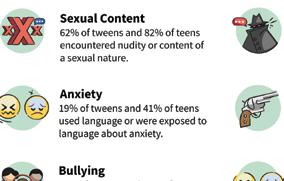
At CoastConnect, we understand the challenges of keeping children safe in today’s digital world. That’s why we’ve decided to o er Bark Premium, a comprehensive parental control app. To add Bark to your monthly package, call us at 877-969-3884.
At CoastConnect, we understand the challenges of keeping children safe in today’s digital world. That’s why we’ve decided to o er Bark Premium, a comprehensive parental control app. To add Bark to your monthly package, call us at 877-969-3884.
Contact us at 877-969-3884 to sign up today. At CoastConnect, we understand the challenges of keeping children safe in today’s digital world. That’s why we’ve decided to offer Bark Premium, a comprehensive parental control app. Bark is available in the Ultimate Connected Home, Family Guardian and Family Guardian Plus bundles.



At CoastConnect, we challenges of keeping digital world. That’s o er Bark Premium, parental control app. monthly package, call















































When outdoor temperatures soar, our electricity use increases. That’s because our air conditioners are running longer and more often to counteract sweltering outdoor temperatures. Factor in that we all tend to use electricity at the same times — in the morning and early evenings — and that equals a lot of strain on our electric grid.
At Delta Electric, we work closely with Cooperative Energy, our local generation and transmission (G&T) cooperative in resource and infrastructure planning to ensure you have the power you need whenever you flip a switch, but the electric grid is much larger than your local co-op and G&T.







In summer months, when even more electricity is being used simultaneously across the country, it is possible for electricity demand to exceed supply, especially if a prolonged heat wave occurs. If this happens, which is rare, the grid operator for our region of the country may call on consumers to actively reduce their energy use or initiate rolling power outages to relieve pressure on the grid. Delta Electric will always keep you informed about situations like this. We work proactively with our G&T to create a resilient portion of the grid and ensure electric reliability in extreme weather, including regular system maintenance, grid modernization e orts and disaster response planning, but it takes everyone to keep the grid reliable.

To help keep the air conditioner running for you, your family and neighbors, here are a few things you can do to relieve pressure on the grid during times of extreme summer heat:
• Select the highest comfortable thermostat setting and turn it up several degrees whenever possible. Your cooling system must run longer to make up the di erence between the thermostat temp and the outdoor temp.
– Pro tip: Seal air leaks around windows and exterior doors with caulk and weatherstripping. Air leaks and drafts force your cooling system to work harder than necessary.
• Use ceiling fans to make yourself feel a few degrees cooler. Remember, ceiling fans cool people (not rooms), so turn them o in unoccupied rooms.
– Pro tip: During summer months, set ceiling fan blades to rotate counterclockwise, which pushes cool air down for a windchill e ect.
• Run major appliances, such as dishwashers, ovens, and dryers, during o -peak hours when the demand for electricity is lower.
– Pro tip: Start the dishwasher before you go to bed.
• Close blinds, curtains and shades during the hottest part of the day to block unwanted heat gain from sunlight.
– Pro tip: Consider blackout curtains with thermal backing or reflective lining to block heat and light.
• Use smaller appliances, such as slow cookers, air fryers, and toaster ovens, to cook meals.
– Pro tip: Studies have shown that air fryers use about half the amount of electricity than a full-sized oven. Air fryers are smaller and use focused heat, which results in faster cooking times, less heat output, and lower energy use.
As we face the challenges posed by soaring summer temperatures, understanding the impact on energy demand is crucial for maintaining a reliable power supply. By adopting energy conservation practices during periods of extreme heat, not only can you save money on your electric bills, but you can also contribute to the resilience of the grid, keeping our local community cool and connected.















QWhat are some energy e ciency upgrades I should consider when building a new house?



APrioritizing energy e ciency when building a new home can create future savings and make living more comfortable. It might cost a little more upfront but will pay o in the long run.


by Miranda Boutelle

Let’s explore two approaches: Following an energy e ciency certification plan or adding energy e cient designs and equipment to your construction project.
There are several e ciency certifications available for new-construction homes that may qualify for discounted homeowner’s insurance, tax credits, and other incentives.
Leadership in Energy and Environmental Design (LEED) certification ensures the home uses less energy while prioritizing sustainable resources and healthy indoor air quality. LEED-certified homes use 20% to 30% less energy than the average home — with some homes saving up to 60% — and can cost the same as non-LEED homes with proper planning, according to the U.S. Green Building Council.


Passive House certification requires the home to be so e cient it needs little to no heating and cooling equipment while remaining comfortable for its occupants. To achieve up to 90% less energy use than the average home, the certification focuses on maximizing the e ciency of the building envelope — all components that separate the indoors from the outdoors — including proper insulation levels, air sealing and high-e ciency windows.
ENERGY STAR® NextGen Certification for New Homes recognizes houses that are 20% more e cient than the average home and help reduce greenhouse gas emissions by 40% to 80%.
Although various certifications are available, you don’t have to follow a set guide. Consider adding these energy e ciency principles to your new home build.





Advanced framing techniques maximize the amount of insulated area and save on material costs in woodframed homes. This technique can save up to $500 for a 1,200-square-foot home and $1,000 for a 2,400square-foot home on material costs, between 3% to 5% on labor costs and up to 5% on annual heating and cooling costs, according to the U.S. Department of Energy. Choose a contractor who is familiar with these techniques, and check with your local building o cials to ensure compliance with local codes.
The importance of a home’s orientation is often overlooked. According to the International Association of Certified Home Inspectors, homes oriented to the path of the sun use less energy for heating and cooling to reduce energy bills and improve comfort.
Advanced framing techniques maximize the amount of insulated area and save on material costs in wood-framed homes. This technique can save up to $500 for a 1,200-square-foot home and $1,000 for a 2,400-square-foot home on material costs.
If you are building or buying a new home that doesn’t allow options for orientation or framing, you might be able to request higher insulation levels in the attic. Increasing the insulation levels likely won’t cost much more for materials and labor, but it can help you use less energy and save money in the long run.
Heating and cooling equipment should be properly sized using energy modeling tools that calculate the home’s heating and cooling needs. Investing in a more e cient building envelope that is well insulated and air sealed can reduce the home’s heating and cooling load, making it possible to have a smaller, less expensive heating and cooling system. This saves money on equipment costs and lowers energy use.
Optimizing the e ciency of a new home requires a whole-house approach. Analyze all systems and how they work together to ensure maximum e ciency for a safe and comfortable home.
Miranda Boutelle is the chief operating o cer at E ciency Services Group in Oregon, a cooperatively owned energy e ciency company.






















by Michael Leitman
Providing members with safe, reliable, and a ordable power is the mantra for electric cooperatives across the nation. Co-op members can see the work necessary to maintain reliable electricity at the local level, such as co-op lineworkers maintaining utility poles and wires and repairing them after major storms. At the regional and national levels, a diverse mix of power generation resources, transmission lines, and pipeline infrastructure are essential cornerstones of maintaining reliable electricity.
The U.S. electric grid has undergone major changes over the last decade. The share of electricity generated from coal plants has declined significantly, while the share from natural gas and intermittent wind and solar generation has grown. Fuel diversity means that your electricity is supplied by a variety of generation technologies, each with their own characteristics and performance capabilities over di erent weather and seasonal conditions.
Dispatchable technologies can be turned on and o as needed. Large steam generation plants (most commonly using coal or nuclear fuels) are generally considered “baseload,” meaning that they are designed to run e ciently 24/7 to serve as the base of the electricity mix. However, steam plants are less capable of ramping output up or down to meet the various peaks and dips as grid conditions change.
Natural gas is the most versatile fuel, powering large combinedcycle plants that can operate as baseload but are also more flexible ramping up and down. These capabilities are essential for meeting demand on the hottest and coldest days, and for balancing intermittent renewable energy sources, such as solar and wind.
Most hydroelectric power comes from generators inside large dams, which can be dispatched when needed — as long as there is enough water available. Cooperative Energy, a Mississippi generation and transmission cooperative, has several contracts to buy hydroelectric power from the Southeastern Power Administration.
Over the last decade, the share of electricity generated from wind and solar plants has increased dramatically. These beneficial, “no-fuel-required” plants can deliver low-cost electricity — but they only generate electricity when the wind blows and the sun shines. The production patterns of solar and wind technologies are complimentary to one another. Solar generates during the day and wind tends to generate more at night. Across seasons, wind output is typically higher during the colder months when there is less sunshine. Deployed together, wind and solar technologies can balance each other. Although there is a limited availability of wind power in Mississippi, there is a small amount that supplements power in the state from The Midcontinent Independent System Operation (MISO), a regional power reliability group that counts the state as a member.
















While battery energy storage technology is growing rapidly to allow some control of when renewable energy sources can be dispatched, natural gas plants remain the primary method for “firming” renewable generation resources.
Ultimately, our electric grid is most reliable when a wide range of technologies is available. When conditions lead to lower generation from one type of source, others can help compensate. When there is an imbalance, such as a major winter storm when electricity use skyrockets, grid operators are forced to rely on purposefully reducing demand and occasionally plan rolling blackouts to keep the grid operating.
While there is variation across regions in what types of power plants can be built based on weather and infrastructure, America’s electric cooperatives work diligently to ensure a diverse and reliable power supply for the communities they serve.

Our electric grid is most reliable when a wide range of technologies, including traditional and renewable energy sources, is available.


















Summer means di erent things to di erent people. For some, it’s planning that long-awaited beach vacation. For others, it’s juggling summer camps, ball games, or just trying to keep cool during the Mississippi heat. And for our kids—it’s freedom. School’s out; bedtimes are looser, and the days stretch long and wide with possibility.
But as routines shift, so do our responsibilities—especially when it comes to keeping our homes and families safe. Whether your house is empty while you're away on vacation, or your children are home alone during the day, today’s smart technology o ers simple ways to ease your mind and help you stay connected.
Smart devices like doorbell cameras, motion detectors, smart locks, and even voice assistants can give you a window into your home, no matter where you are. If you’re traveling, you can use smart devices, such as smart lighting or smart plugs, to turn lights on and o in the evening to make it look like someone’s home. Motion-activated outdoor lights can deter unwanted visitors, while indoor security cameras can notify you instantly if something doesn’t seem right.
Many of these devices are easy to install and can be controlled right from your phone. A quick glance at a live camera feed or instant movement notifications at your home or property can o er the peace of mind you need to fully relax and enjoy your time away.
If you have older kids spending the day at home alone, smart tech can help you check in to make sure they’re safe and sound. A smart doorbell can alert you if someone rings the bell or if your child opens an exterior door to go outside. Indoor cameras in common areas—like the kitchen or living room—allow you to peek in periodically and make sure everything’s okay. Many parents even











set up quick video calls at lunchtime using their child’s Wi-Ficonnected device. These tools o er reassurance, for both parents and kids, that help is just a call or tap away if needed.
Of course, all this depends on having a strong, reliable internet connection. Through DE Fastlink, we’re proud to be able to provide the service that makes this kind of peace of mind possible, but more than that, we’re here because we care about our community.
Summer should be a season of joy, not worry. Whether you’re planning a trip, enjoying a staycation, or navigating the new rhythm of kids at home, we hope you find ways to protect what matters most—and to make memories along the way.









by Randy Smith General Manager













by Amanda Mills
Following the success of our 16th Annual Charity Golf Tournament, we were proud to deliver checks to this year’s four beneficiaries. Thanks to the incredible generosity of our sponsors, community partners, and employees, each organization received $4,710.
These funds will directly support local e orts to fight food insecurity and provide critical resources to families in need. The Glory House in Laurel, Junior Auxiliary of Laurel, Junior Auxiliary of Wayne County, and Calvary Baptist Church of Petal each play a unique role in serving their communities, and we’re honored to help further their missions.
Whether you played, sponsored, donated, or volunteered, your support helped make this tournament more than just a day on the course—it became a meaningful investment in the well-being of our neighbors.
Thank you to everyone who made this year’s tournament such a resounding and heartfelt success!




Osmose Utilities Services will be performing inspection and maintenance on some of Dixie Electric Power Association’s poles during the next year, beginning in May and continuing for approximately four months. The general areas to be inspected will be Clara, Buckatunna, Winchester, Progress, Chicora, Denham, Matherville, Waynesboro, Diamond, Hiwannee, Yellow Creek, Liberty, Waller Ridge, and Maynor Creek.
This work will generally consist of excavating a hole about 18”
deep around the poles to inspect them and applying a preservative and/or remedial treatment to the poles as needed. The purpose of the inspection and treatment is to identify poles that do not meet industry strength standards and to extend the useful life of all others.
All Osmose contract workers will be identifiable by their yellow and orange Osmose work vests and hard hats. Osmose vehicles should be marked with Osmose Utility decals as well as a Dixie Electric Power Association “Contractor” decals.
























by Amanda Mills
There’s a lot to love about summer in Mississippi — the longer days, family cookouts, and maybe even a little vacation time if we’re lucky. But let’s be honest: the heat can be downright brutal, and with it often comes something none of us look forward to — higher electric bills.
As someone who’s balancing a household just like many of you, I get it. When it’s pushing 100 degrees outside, turning down the thermostat feels like the only option. But there are actually some simple ways to stay comfortable and keep those bills in check without sweating it out indoors.
Here are a few practical tips I use at home, and maybe they’ll work for your family too:
1. Find your comfort sweet spot
We’ve all heard that 78°F is the recommended summer setting— but let’s be real: in South Mississippi, that’s not always doable. When it’s 100 degrees outside with 90% humidity, sometimes comfort has to take priority. And that’s okay. Just remember comfort comes at a cost. So instead of aiming for a specific number, try to set your thermostat as high as you can while still feeling comfortable in your home. Even nudging it up a degree or two can help lower your bill over time.
2. Keep your curtains and blinds closed.
It’s amazing how much heat pours in through windows. During the hottest part of the day, especially on the sunny side of your home, closing blinds or curtains can block out that heat and help your A/C work less. I even invested in blackout curtains for the rooms that get the most sun — and it’s helped more than I expected.





3. Be strategic with appliances.
4. Check your filters.







Using the oven heats up the whole kitchen, which makes your A/C work overtime. In our house, we grill outside more often in the summer or use the slow cooker or air fryer to keep things cooler inside. Also, keep in mind that appliances like refrigerators and freezers have to work harder in the heat. If you have a deep freezer stored in a garage or on a porch, it’s likely using a lot more electricity just to maintain temperature. If possible, move it to a cooler, shaded spot—or at least make sure it has good ventilation to help it run more e ciently.
I know—this one is easy to forget. But dirty air filters force your system to work harder, which uses more energy. Setting a reminder once a month to check and replace them is a small habit that can make a big impact.
5. Use fans to help you feel cooler.
Ceiling fans don’t lower the temperature in the room, but they do make you feel cooler by circulating the air. When one is available, try using a fan first before reaching for the thermostat—you might find you’re comfortable without adjusting the A/C at all. Just be sure to turn fans o when you leave a room to save energy.
None of us can control the weather, but we can control how we respond to it. A few small changes here and there can go a long way in managing your energy use without sacrificing comfort. Summer in Mississippi will always bring the heat—but with a little planning, we don’t have to let it burn through our wallets, too.
Stay safe, stay cool, and enjoy your summer!

























DeKalb 601-743-2641 • Louisville 662-773-5741 • Quitman 601-776-6271 • Meridian / After-Hours Outages 601-581-8600
MEMBER OWNED. LOCALLY OPERATED. THAT’S THE COOPERATIVE DIFFERENCE.
The “dog days of summer” span from July 3 to Aug. 11 — forty long, hot, and sultry days rooted in ancient astronomy. Historically, this season followed the heliacal rising of Sirius, the Dog Star, which the Greeks and Romans associated with extreme heat, drought, sudden storms, fever and even misfortune. Today, we simply recognize it as the most sweltering stretch of summer in the Northern Hemisphere — when tempers are short, humidity is high, and air conditioners run nearly nonstop.
Here at East Mississippi Electric Power Association, dog days began early. Unseasonably hot weather started in May and hasn’t let up since. Along with the heat have come frequent, sudden storms — many packing lightning and high winds. Nearly every evening and weekend, somewhere along the 5,786 miles of distribution lines we maintain, our crews respond to service interruptions. Whether it’s a lightning strike blowing a fuse, a fallen tree limb or even a broken pole, the challenges are constant.
To put those 5,786 miles into perspective — that’s enough line to stretch from Meridian to San Francisco, then to Washington, D.C. and back to Meridian. And every mile is maintained around the clock, 24/7, by a dedicated team committed to keeping your homes cool and your lives comfortable.
When a storm hits and an outage occurs, our automated meter-reading system instantly alerts me with details on how many meters are a ected. I open our app, watch our crews deploy, and like many of you, I hope and pray for their safety as they work quickly to restore service. We update our social media channels with real-time information, so you can stay

informed, and I want you to know that we see and appreciate the encouraging comments you leave.
Nearly every day, whether at church, in the community or in the checkout line, I hear words of thanks for our employees. Many of you understand the long hours and extreme weather they face, but what you might not fully realize is the depth of training they undergo to serve you. This is not just a job — it’s a calling.
Our linemen and technicians study extensively to ensure they can safely build, operate, and maintain a distribution system that meets your needs and weathers the storms. They’re trained not only to handle the physical demands of the job but also to swiftly diagnose problems, make safe repairs, and prevent future outages.
Working at EMEPA isn’t just a career, it’s a lifelong commitment to service. Many of us have spent the better part of our lives here, dedicated to powering the communities we love. And we look forward to continuing that mission for years to come.
During these dog days of summer, we’re reminded not just of the heat, but of the resilience and reliability of the people who keep the power flowing — day and night, rain or shine.
Thank you for trusting us. It’s our privilege to serve you.

by Randy Carroll
CEO — East Mississippi Electric Power Association
Our employees will observe Independence Day, and our o ces will be closed Friday, July 4, for the holiday.










What are some energy e ciency upgrades I should consider when building a new house?





APrioritizing energy e ciency when building a new home can create future savings and make living more comfortable. It might cost a little more upfront but will pay o in the long run.


by Miranda Boutelle

Let’s explore two approaches: Following an energy e ciency certification plan or adding energy e cient designs and equipment to your construction project.
There are several e ciency certifications available for newconstruction homes that may qualify for discounted homeowner’s insurance, tax credits, and other incentives.
Leadership in Energy and Environmental Design (LEED) certification ensures the home uses less energy while prioritizing sustainable resources and healthy indoor air quality. LEED-certified homes use 20% to 30% less energy than the average home — with some homes saving up to 60% — and can cost the same as non-LEED homes with proper planning, according to the U.S. Green Building Council.
Passive House certification requires the home to be so e cient it needs little to no heating and cooling equipment while remaining comfortable for its occupants. To achieve up to 90% less energy use than the average home, the certification focuses on maximizing the e ciency of the building envelope — all components that separate the indoors from the outdoors — including proper insulation levels, air sealing and high-e ciency windows.
ENERGY STAR® NextGen Certification for New Homes recognizes houses that are 20% more e cient than the average home and help reduce greenhouse gas emissions by 40% to 80%.
Although various certifications are available, you don’t have to follow a set guide. Consider adding these energy e ciency principles to your new home build.
Advanced framing techniques maximize the amount of insulated area and save on material costs in wood-framed homes. This technique can save up to $500 for a 1,200-square-foot home and $1,000 for a 2,400-square-foot home on material costs, between 3% to 5% on labor costs and up to 5% on annual heating and cooling costs, according to the U.S. Department of Energy. Choose a contractor who is familiar with these techniques, and check with your local building o cials to ensure compliance with local codes.
The importance of a home’s orientation is often overlooked. According to the International Association of Certified Home Inspectors, homes oriented to the path of the sun use less energy for heating and cooling to reduce energy bills and improve comfort.


If you are building or buying a new home that doesn’t allow options for orientation or framing, you might be able to request higher insulation levels in the attic. Increasing the insulation levels likely won’t cost much more for materials and labor, but it can help you use less energy and save money in the long run.

Properly insulating while building a home can reduce the expense of your heating and cooling equipment and lead to long-term energy savings.
Heating and cooling equipment should be properly sized using energy modeling tools that calculate the home’s heating and cooling needs. Investing in a more e cient building envelope that is well insulated and air sealed can reduce the home’s heating and cooling load, making it possible to have a smaller, less expensive heating and cooling system. This saves money on equipment costs and lowers energy use.
Optimizing the e ciency of a new home requires a whole-house approach. Analyze all systems and how they work together to ensure maximum e ciency for a safe and comfortable home.
Miranda Boutelle is the chief operating o cer at E ciency Services Group in Oregon, a cooperatively owned energy e ciency company.


















East Mississippi Electric Power Association will host its 87th Annual Meeting of the Membership on Saturday, Oct. 4, 2025, at the EMEPA Meridian Auditorium.






O cial notices will be mailed to all members later this month. The Annual Meeting is your opportunity to hear updates on the Association’s work over the past year, participate in the election of three directors, and be part of the decisions that shape our cooperative’s future.
As required by EMEPA’s bylaws, a quorum of the membership — either in person or by proxy — is needed to conduct business and hold the director elections. Plus, all participating members are eligible to win electricity credits up to $500.
Members can request a full copy of EMEPA’s bylaws by contacting any of our district o ces in Louisville, DeKalb, or Quitman, or the main o ce in Meridian.
Mark your calendar for Oct. 4 and make plans to join us. Your voice and your vote matter.
Questions? Call us at 601-581-8600 or visit emepa.com to learn more.




Hurricanes can bring powerful winds, flooding rains, and widespread power outages. Even further inland, preparation is key to staying safe. Taking time now to plan and protect your home can make all the di erence when a storm approaches.
Know your risks — are you vulnerable to storm surge, flooding, or tornadoes? Find out if you live in a flood zone or evacuation area. Stock up on essentials like food, water, batteries, and cash, and make sure your insurance is up to date. Secure your home by covering windows, anchoring loose items and documenting your belongings. Also, create a communication plan with family and friends in case you get separated.




During the storm:
Rely on trusted sources such as the National Hurricane Center for forecast updates. Understand the alerts — watches mean conditions are possible, while warnings mean they’re expected. Stay in a safe place away from water and wind and avoid unnecessary travel. Check on neighbors, especially those who are elderly or vulnerable.
After the storm:
Even when skies clear, dangers remain. Watch out for downed powerlines and flooded roads. Clean up safely, and never use a generator indoors or connect it directly to your home’s meter without a professionally installed transfer switch. Stay alert. Stay prepared. Stay safe.
safety and preparedness info, visit our Storm and Outage Center at EMEPA.com.
When summer arrives, the right connection can turn an ordinary season into one full of adventure, creativity and connection. East Mississippi Connect’s high-speed fiber internet makes it easy for families to enjoy a more successful, fun-filled summer—all without leaving home. Whether you’re planning virtual vacations, launching creative projects or keeping cool with smart home devices, EMC internet provides the speed and reliability you need for every summer success story.
Take virtual tours of famous landmarks, museums and parks. Apps like Google Earth and YouTube and museum websites o er incredible adventures that require strong, stable internet—something EMC delivers every day.
Start
Thinking about starting an online shop, blog or crafting business? EMC’s high upload and download speeds make it easy to build websites, sell products or stream content without lag or interruptions.
From smart thermostats to energy-e cient lighting systems, EMC’s fiber connection ensures your smart devices operate smoothly—helping you save energy and stay comfortable all summer long.
• Strengthen Your Wi-Fi: Place your router in a central location to maximize coverage for all your devices—indoors and outside on the patio!




























Keep Learning and Growing Summer learning programs are just a click away with EMC fiber. Educational apps like Khan Academy, Outschool and Duolingo keep kids and adults sharp, making sure summer is both fun and enriching.








Use apps like Zoom, FaceTime or Google Meet to catch up with loved ones, no matter where they are. With EMC’s reliable video streaming, virtual game nights, birthday parties and family check-ins happen without a glitch.









































• Use Parental Controls: Keep kids safe online with built-in controls and screen time limits on your Wi-Fi network.
• Download Before You Go: Heading on a road trip? Download shows, playlists and educational content ahead of time using EMC’s fast speeds.

• Smart Savings: Connect smart home systems to optimize energy use and reduce your summer cooling costs.




















With East Mississippi Connect, your summer can be more adventurous, more productive and more connected than ever.







































































For the third year, Magnolia Electric Power linemen took on the Miracle League’s Pirates. The score was Pirates 99, Linemen 11. The action-packed game was held recently at the McComb Sportsplex.
This year the MEP linemen decided to accessorize their team shirts with pink tutus and pink glasses. The fun and laughs were aplenty as the teams faced o for the game.



Even with a runaway score, everybody gathered for a group photo at the end of the game.
The Miracle League is a nonprofit baseball league for individuals with special needs.
If you would like to know more about them, please go to Facebook and search for McComb Miracle League.
MEP would like to o er congratulations to the Pirates!















Our members in the Progress community may have seen workers wearing bright yellow or orange vests walking the roads over the last month. The workers are with Utility Asset Management, a company based out of Oklahoma, and they have been inspecting Magnolia Electric Power’s power poles.
“By having the power poles inspected, we are able to maintain a reliable power system. This process helps us identify poles that need attention,” said Manager of Operations Daniel Evans. “Once the pole inspection process is complete, we will send power line crews back to repair, or replace, poles as needed.
The inspections have taken a couple of months, which means they are nearing the completion.”
James McGuire, project manager for Utility Asset Management, has led the crew that is currently working on the inspections. MEP caught up with him at the end of April and interviewed him about the process. MEP posted that article to Facebook on May 1.
At that time, McGuire, and his wife, Julie, who works as a field technician with the company, were inspecting power poles on Mt. Herman Road in Progress. They work as a team to inspect the poles in a general area.
While the McGuires were working in one specific area, the rest of McGuire’s crew was scattered across the area working on other parts of the circuit.
Collectively, the crew can inspect 400 to 600 poles a day, taking an average of three-to-five minutes to inspect each pole. MEP contracted them to inspect 9,200 power poles.
To sum up what the team has been doing with the pole inspections, it includes creating a digital image of every pole, fine tuning the GPS coordinates, taking a full profile picture of the pole, taking a picture of the top of the pole, tagging the pole with an inspection tag to verify they have been there, checking the rot of the pole with an ultra-probe machine, and checking the shell of the pole at the base.



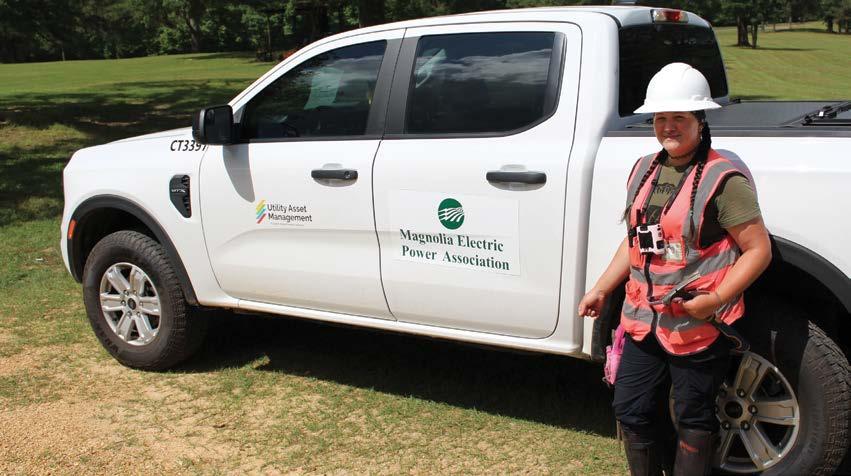
The ultra-probe is one of the more interesting aspects of their inspection procedure.
According to their website, Utility Asset Management’s “analysis algorithms have been developed with real pole breaking data in conjunction with Mississippi State University. Our R&D group is recognized industry-wide for its ground-breaking research. This process uses time of flight and peak energy of ultrasound to determine if there are inconsistencies on the inside of a pole.”
And out in the field, that translates to the crew using technology to analyze the power poles in quite a unique way.
After tagging the pole, the crewmember will attach an ultraprobe machine that sends a sound wave through the base.
“How the sound dissipates tells the condition of the wood cellulose inside and lets us know if there is rot or decay in the pole,” McGuire said. “There are a lot of things you can tell from sound alone.”
But the crewmember will go a step further and perform a personal sound test of the pole by striking it.
“We strike the pole four times from the ground up to three feet from the ground — around the pole’s perimeter — to see if we can detect or hear any cavities,” McGuire said. “We only drill in a pole if there is any indication of decay.”
The crewmember will do one final inspection called the Lineman Test — and that means taking a spike and hammering it in the pole at the ground-line to see if the spike penetrates the pole’s shell.
Here is a list of the steps the crews take to do a pole inspection.
• Take pictures
• Looking for visible signs of damage
• Hammer test
• Shell rot test
• Attach their tag
• Attach the probe
• Run the probe
• Verify the diagnostic
Utility Asset Management has a fleet of trucks and other equipment.
“We have two Ford Rangers, three Nissans Frontiers (two red Nissans, one white Nissan), two Artic Cat 300 ATVs all with Oklahoma tags, and a Ford Maverick with an Indiana tag,” McGuire said.
The employees themselves have traveled from Florida, West Virginia, and North Carolina to come and perform the inspections. The inspections are something they do across the country.
The crew began with eight people working and were joined later by three additional employees during the process. The crew consists of two di erent husband and wife teams.
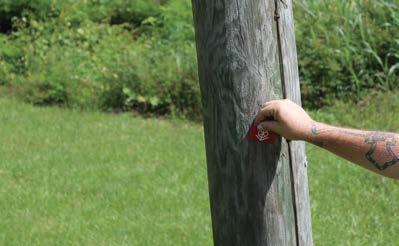




Our members may have seen the crew members walking from pole to pole with some occasionally on four wheelers in certain areas.
Also, the crew works on weekends.
You may have seen their trucks parked on the roadside for 30 minutes to an hour as the crew members walks between the poles.
Their parked trucks should have had a “MEP Comfort Letter” on the dashboard as to why it is parked in that spot.


Our members can also call dispatchers at MEP for verification of where the crew is working. are









If you would like more information on the company or the procedures, please go to their website at gridmgr.com/inspection-process/.





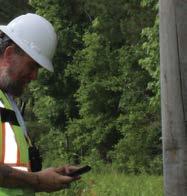



















Walthall County’s long-running house party and homecoming returns this year, with the Walthall County Dairy Festival slated for June 7 at Holmes Water Park in Tylertown.
This marks the 48th year of the festival, started in 1977 by local dairy farmers and the cooperative extension service as a way of thanking the county for its support of what was then the leading agricultural enterprise in the county.
As dairying in the Southeastern U.S. began declining in later years, the festival was taken over by a volunteer group as a means of honoring the memory of the family farms that helped drive the economy of the county, and as a summer attraction that continues to this day as a free family festival. The event honors the farming tradition of the area, now diversified into forestry, livestock, poultry, and other agricultural pursuits.
The festival — put on by a group of volunteers — has continued to grow over the years. The event is channeled through the Walthall County Chamber of Commerce and is considered one of the oldest and best family-oriented festivals in the state.
The festival will feature live entertainment, food vendors, pageants, ice cream eating and butter churning contests, a flower show, an antique car show and the International Turtle Races.
The grand finale of the festival is a fireworks display sponsored by Citizens Bank at 9 p.m.




















































AMORY – P.O. BOX 300 - 50408 GREENBRIAR ROAD – 662-256-2962 • CALEDONIA – 746 MAIN STREET – 662-356-4100




















When outdoor temperatures soar, our electricity use increases. That’s because our air conditioners are running longer and more often to counteract sweltering outdoor temperatures. Factor in that we all tend to use electricity at the same times — in the morning and early evenings — and that equals a lot of strain on our electric grid.
At Monroe County Electric, we work closely with the Tennessee Valley Authority (TVA), our local generation and transmission (G&T) cooperative in resource and infrastructure planning to ensure you have the power you need whenever you flip a switch, but the electric grid is much larger than your local co-op and G&T.





In summer months, when even more electricity is being used simultaneously across the country, it is possible for electricity demand to exceed supply, especially if a prolonged heat wave occurs. If this happens, which is rare, the grid operator for our region of the country may call on consumers to actively reduce their energy use or initiate rolling power outages to relieve pressure on the grid. Monroe County Electric will always keep you informed about situations like this. We work proactively with our G&T to create a resilient portion of the grid and ensure electric reliability in extreme weather, including regular system maintenance, grid modernization e orts, and disaster response planning, but it takes everyone to keep the grid reliable.

To help keep the air conditioner running for you, your family and neighbors, here are a few things you can do to relieve pressure on the grid during times of extreme summer heat:
• Select the highest comfortable thermostat setting and turn it up several degrees whenever possible. Your cooling system must run longer to make up the di erence between the thermostat temp and the outdoor temp.
– Pro tip: Seal air leaks around windows and exterior doors with caulk and weatherstripping. Air leaks and drafts force your cooling system to work harder than necessary.
• Use ceiling fans to make yourself feel a few degrees cooler. Remember, ceiling fans cool people (not rooms), so turn them o in unoccupied rooms.
– Pro tip: During summer months, set ceiling fan blades to rotate counterclockwise, which pushes cool air down for a windchill e ect.
• Run major appliances, such as dishwashers, ovens, and dryers, during o -peak hours when the demand for electricity is lower.
– Pro tip: Start the dishwasher before you go to bed.
• Close blinds, curtains and shades during the hottest part of the day to block unwanted heat gain from sunlight.
– Pro tip: Consider blackout curtains with thermal backing or reflective lining to block heat and light.
• Use smaller appliances, such as slow cookers, air fryers, and toaster ovens, to cook meals.
– Pro tip: Studies have shown that air fryers use about half the amount of electricity than a full-sized oven. Air fryers are smaller and use focused heat, which results in faster cooking times, less heat output, and lower energy use.
As we face the challenges posed by soaring summer temperatures, understanding the impact on energy demand is crucial for maintaining a reliable power supply. By adopting energy conservation practices during periods of extreme heat, not only can you save money on your electric bills, but you can also contribute to the resilience of the grid, keeping our local community cool and connected.













QWhat are some energy e ciency upgrades I should consider when building a new house?



APrioritizing energy e ciency when building a new home can create future savings and make living more comfortable. It might cost a little more upfront but will pay o in the long run.


by Miranda Boutelle

Let’s explore two approaches: Following an energy e ciency certification plan or adding energy e cient designs and equipment to your construction project.
There are several e ciency certifications available for new-construction homes that may qualify for discounted homeowner’s insurance, tax credits, and other incentives.
Leadership in Energy and Environmental Design (LEED) certification ensures the home uses less energy while prioritizing sustainable resources and healthy indoor air quality. LEED-certified homes use 20% to 30% less energy than the average home — with some homes saving up to 60% — and can cost the same as non-LEED homes with proper planning, according to the U.S. Green Building Council.


Passive House certification requires the home to be so e cient it needs little to no heating and cooling equipment while remaining comfortable for its occupants. To achieve up to 90% less energy use than the average home, the certification focuses on maximizing the e ciency of the building envelope — all components that separate the indoors from the outdoors — including proper insulation levels, air sealing and high-e ciency windows.
ENERGY STAR® NextGen Certification for New Homes recognizes houses that are 20% more e cient than the average home and help reduce greenhouse gas emissions by 40% to 80%.
Although various certifications are available, you don’t have to follow a set guide. Consider adding these energy e ciency principles to your new home build.





Advanced framing techniques maximize the amount of insulated area and save on material costs in woodframed homes. This technique can save up to $500 for a 1,200-square-foot home and $1,000 for a 2,400square-foot home on material costs, between 3% to 5% on labor costs and up to 5% on annual heating and cooling costs, according to the U.S. Department of Energy. Choose a contractor who is familiar with these techniques, and check with your local building o cials to ensure compliance with local codes.
The importance of a home’s orientation is often overlooked. According to the International Association of Certified Home Inspectors, homes oriented to the path of the sun use less energy for heating and cooling to reduce energy bills and improve comfort.
Advanced framing techniques maximize the amount of insulated area and save on material costs in wood-framed homes. This technique can save up to $500 for a 1,200-square-foot home and $1,000 for a 2,400-square-foot home on material costs.
If you are building or buying a new home that doesn’t allow options for orientation or framing, you might be able to request higher insulation levels in the attic. Increasing the insulation levels likely won’t cost much more for materials and labor, but it can help you use less energy and save money in the long run.
Heating and cooling equipment should be properly sized using energy modeling tools that calculate the home’s heating and cooling needs. Investing in a more e cient building envelope that is well insulated and air sealed can reduce the home’s heating and cooling load, making it possible to have a smaller, less expensive heating and cooling system. This saves money on equipment costs and lowers energy use.
Optimizing the e ciency of a new home requires a whole-house approach. Analyze all systems and how they work together to ensure maximum e ciency for a safe and comfortable home.
Miranda Boutelle is the chief operating o cer at E ciency Services Group in Oregon, a cooperatively owned energy e ciency company.






















by Michael Leitman
Providing members with safe, reliable, and a ordable power is the mantra for electric cooperatives across the nation. Co-op members can see the work necessary to maintain reliable electricity at the local level, such as co-op lineworkers maintaining utility poles and wires and repairing them after major storms. At the regional and national levels, a diverse mix of power generation resources, transmission lines, and pipeline infrastructure are essential cornerstones of maintaining reliable electricity.
The U.S. electric grid has undergone major changes over the last decade. The share of electricity generated from coal plants has declined significantly, while the share from natural gas and intermittent wind and solar generation has grown. Fuel diversity means that your electricity is supplied by a variety of generation technologies, each with their own characteristics and performance capabilities over di erent weather and seasonal conditions.
Dispatchable technologies can be turned on and o as needed. Large steam generation plants (most commonly using coal or nuclear fuels) are generally considered “baseload,” meaning that they are designed to run e ciently 24/7 to serve as the base of the electricity mix. However, steam plants are less capable of ramping output up or down to meet the various peaks and dips as grid conditions change.
Natural gas is the most versatile fuel, powering large combinedcycle plants that can operate as baseload but are also more flexible ramping up and down. These capabilities are essential for meeting demand on the hottest and coldest days, and for balancing intermittent renewable energy sources, such as solar and wind.
Most hydroelectric power comes from generators inside large dams, which can be dispatched when needed — as long as there is enough water available. Cooperative Energy, a Mississippi generation and transmission cooperative, has several contracts to buy hydroelectric power from the Southeastern Power Administration.
Over the last decade, the share of electricity generated from wind and solar plants has increased dramatically. These beneficial, “no-fuel-required” plants can deliver low-cost electricity — but they only generate electricity when the wind blows and the sun shines. The production patterns of solar and wind technologies are complimentary to one another. Solar generates during the day and wind tends to generate more at night. Across seasons, wind output is typically higher during the colder months when there is less sunshine. Deployed together, wind and solar technologies can balance each other. Although there is a limited availability of wind power in Mississippi, there is a small amount that supplements power in the state from The Midcontinent Independent System Operation (MISO), a regional power reliability group that counts the state as a member.
















While battery energy storage technology is growing rapidly to allow some control of when renewable energy sources can be dispatched, natural gas plants remain the primary method for “firming” renewable generation resources.
Ultimately, our electric grid is most reliable when a wide range of technologies is available. When conditions lead to lower generation from one type of source, others can help compensate. When there is an imbalance, such as a major winter storm when electricity use skyrockets, grid operators are forced to rely on purposefully reducing demand and occasionally plan rolling blackouts to keep the grid operating.
While there is variation across regions in what types of power plants can be built based on weather and infrastructure, America’s electric cooperatives work diligently to ensure a diverse and reliable power supply for the communities they serve.
Michael Leitman writes on consumer and cooperative a airs for the National Rural Electric Cooperative Association

Our electric grid is most reliable when a wide range of technologies, including traditional and renewable energy sources, is available.

















Spring in Washington means cherry blossoms, major league baseball, playo hockey, and the convergence of hundreds of electric cooperative leaders from across the country. Administrations and policy seemingly change every 4 years, but the mission of electric cooperatives is consistent.
The process is underway to unwind flawed EPA regulations. The power plant rule called for the premature closing of power plants that puts the reliability of our grid in question. The rule prescribes unproven technology in an unworkable timeframe.
We are seeing the fruits of these rollbacks in the Tennessee Valley Authority (TVA) area immediately as TVA has already decided to re-evaluate the closure of two of its existing coal plants. These aging plants are expensive to run but could keep the TVA generation fleet more diverse and aid in this time of increasing electricity demand.
An issue hindering this e ort is the removal of two TVA directors by the current administration. Moving forward will be di cult without a full board to approve budgets, rates, and large capital projects. TVA has always operated best when able to maintain its independence from strict control of the federal government. It’s






imperative that the current administration appoint new directors, whose values are aligned with the Valley, to accomplish the mission of growing our communities.
Obviously, other items were discussed in our nation’s capital, but these were at the forefront. There is an opportunity through the rollback of poor policy to move forward with generation projects needed to satisfy the demand for electricity in our high growth region. Let’s not let administrative matters and posturing slow us down.
Stay safe.

by Kevin Doddridge General Manager/CEO




























































Jaida Dixon Center Hill High School
Jaida will begin her path toward becoming a nurse anesthetist this fall. She says her mother is her greatest inspiration. Jaida calls her high school journey ‘bittersweet’ — a mix of challenges, memories, and motivation that have prepared her to chase her dreams with purpose.

Vann Gallimore
DeSoto Central High School
Van is setting his sights on a career in the music industry. He describes his high school years as a time of ‘building’ — growing in character, creativity, and confidence. With gratitude for the support of this scholarship, he’s ready to turn up the volume on his future.
We’re proud to recognize these eight graduating seniors as this year’s scholarship winners. Each student will receive a one-time, $2,000 scholarship. These are awarded annually to at least one student from each Northcentral-area school. Applications are posted on our website at the beginning of each school year, with the deadline to apply in early March.
We’re proud to recognize these eight graduating seniors as this year’s scholarship winners. Each student will receive a one-time, $2,000 scholarship. These are awarded annually to at least one student from each Northcentral-area school. Applications are posted on our website at the beginning of each school year, with the deadline to apply in early March.

Emily Shands
DeSoto CTC/Lewisburg High School
Emily has her heart set on becoming a pediatric nurse, driven by a passion for compassion and care. She says this scholarship not only eases the financial burden of college — it also reminds her that others believe in her future. Describing her high school experience as ‘full,’ Emily credits her mentors for helping her grow into a confident young woman ready to give back to others.

Audrey McKnatt Northpoint Christian School
Audrey is heading into the tech world with a strong foundation in faith, family, and service. Studying computer information systems this fall, Audrey plans to stay in the Mid-South and continue giving back through her church and local outreach. Describing her high school journey as one of ‘perseverance,’ she’s proud to have stayed true to herself while building a future centered on purpose and gratitude.

Olive Branch High School
Lydia plans to pursue a career in nursing. Inspired by the encouragement of her teachers and fueled by her own determination, she sees this scholarship as a meaningful step toward her future. Lydia describes her high school experience as ‘bittersweet’ — a journey marked by growth, gratitude, and the hope of making a difference.

Rocio Vasquez-Benitez
Byhalia High School
Rocio is pursuing a future in psychology with the goal of helping others become their best selves. Rocio sees this scholarship as a step toward fulfilling her dreams — and easing the burden on her family. Describing her high school experience as ‘eventful,’ she’s proud of how far she’s come and ready for all that lies ahead.

Cooper McNeely
Lewisburg High School
Cooper plans to pursue a degree in music education and inspire the next generation through the power of music. He describes his high school journey as “transformative,” crediting the Lewisburg High School band program for instilling a strong work ethic and shaping his passion for education.

Landry Loper Marshall Academy
Landry is heading to Mississippi Gulf Coast Community College in the fall to play softball and begin her path toward becoming an anesthesiologist assistant. She is inspired by her parents and guided by a desire to uplift others. She describes her high school experience as ‘impactful’ — both for the way it shaped her, and for the way she’s left her mark.








We are pleased to announce that the 75th annual meeting of the members of Northcentral Electric Cooperative will be held at 2 p.m. on Wednesday, Oct. 29, 2025, in our auditorium located at 4600 Northcentral Way in Olive Branch.
Pursuant to Section 3.01 of the bylaws of the cooperative, the annual meeting shall be held on the fourth Wednesday of October each year, unless for su cient cause, the Board of Directors fixes a di erent date for the annual meeting not more than thirty (30) days before or after the fourth Wednesday in October. In their monthly meeting occurring on Apr. 23, 2025, the Board of Directors voted to change the 2025 meeting date to Oct. 29, due to a previously scheduled conflict.


In addition to a review of the cooperative’s performance over the previous fiscal year, a major component of the Annual Meeting is the election of three members to the Board of Directors.
This year, board members are to be elected from Districts 3, 5, and 7 of the service area. A general description of the areas served in those districts, as well as board qualifications and nomination procedures can be found in Article IV of Northcentral’s bylaws, which are posted on our website at northcentralelectric.com, or they can be viewed in person upon request at the Northcentral o ce.
































COLUMBIA: 601-736-2666 | HATTIESBURG: 601-264-2458 | PURVIS: 601-794-8051 | WIGGINS: 601-928-7277
Pearl River Valley Electric is proud to announce a major safety milestone—500,000 work hours without a time-loss accident. This remarkable achievement reflects the shared commitment of all 134 employees to creating and maintaining a safe work environment.
Achieving this level of safety requires more than just good luck, it demands a strong culture of safety. Our linemen attend regular safety meetings and adhere to rigorous training standards. Pearl River Valley Electric puts safety at the center of everything we do, and each employee plays a role in looking out for one another and following best practices to prevent accidents before they happen.
This milestone is a testament to the dedication and professionalism of our entire workforce, especially our linemen. These men often work in dangerous and challenging conditions, through storms, in high heat, and around dangerous equipment to keep the lights on for our members. Their awareness, training, and focus on safety are essential to this accomplishment.
I thank every employee for making safety a top priority. Reaching 500,000 hours without a time-loss accident is more than just a number, it’s a reflection of the responsibility we feel toward one another, our families, and the communities we serve.

Recently, PRVEPA’s 2024 Cooperative Youth Leader students, Mary Xie and Stevie Thompson, received their Cooperative Youth Leader medallions for participating in the program in 2023/2024. Both students attend Oak Grove High School and will be graduating this spring. In addition to her medallion, Mary also received the Cooperative Energy Scholarship for her work in the program.


Mary is planning to attend the Massachusetts Institute of Technology (MIT) in the fall to major in computer science with an emphasis on AI technology. Stevie Thompson will be attending Ole Miss to major in pre-dental. She plans to become a prosthodontist. Both students were recently honored by being inducted into the Oak Grove Hall of Fame for graduating in the top 16 of their class. We wish them both the best of luck in their future endeavors.





Member owned. Locally operated. That’s the cooperative difference. • Visit us online at www.PRVEPA.com. PAY BILLS or REPORT OUTAGES: 855-2PRVEPA (855-277-8372)






by Matthew Ware
CEO/General Manager













Electric cooperatives take hurricane preparedness seriously. Before a storm makes landfall, cooperatives implement emergency response plans, secure critical infrastructure, and coordinate with state and local agencies.
As a cooperative member, you can take steps to safeguard your home and family, including
• CREATING AN EMERGENCY KIT with essentials like water, non-perishable food, flashlights, batteries, and medications.
• CHARGING ELECTRONIC DEVICES and securing backup power sources if necessary.
• TRIMMING TREES and securing outdoor items to reduce potential damage from strong winds.
• REVIEWING YOUR EVACUATION PLAN and staying informed about storm updates from reliable sources like the National Weather Service and local news.
Once a storm has passed, electric cooperatives move swiftly to assess and repair damage. Restoration e orts follow a systematic approach to safely and e ciently bring power back to members:
1. Damage assessment. Crews inspect infrastructure to identify downed power lines, damaged transformers, and other hazards.
2. Restoring critical infrastructure. Hospitals and emergency services are prioritized to support public health and safety.
3. Repairing main distribution lines. Crews first restore power to the greatest number of members by addressing main transmission lines before moving to smaller distribution lines.
4. Restoring individual services. Once major infrastructure is repaired, crews work on restoring power to homes and businesses with isolated outages.
Electric cooperatives also rely on mutual aid agreements, by bringing in additional crews from other cooperatives to expedite restoration e orts. These coordinated e orts ensure that power is restored as safely and quickly as possible.

Hurricane season is a time of heightened vigilance for electric cooperatives in hurricane prone areas. As storms form and intensify, preparation is key to ensuring the safety of members and the swift restoration of power. At Pearl River Valley Electric we work to have a plan in place to prepare for severe weather and to restore power in a timely manner. Every year we meet to discuss roles and plans in case a major hurricane hits our service territory. Just like how we prepare, it’s important for our members to understand the steps to take before, during, and after a storm to help minimize risks and expedite recovery e orts.

Even after the storm has passed, dangers remain. It is critical to remain cautious and follow these safety guidelines:
• Stay away from downed power lines. Always assume they are live and report them immediately to your electric cooperative.
• Use generators safely. Never operate a generator indoors or in an enclosed space. Place it at least 20 feet away from your home to prevent carbon monoxide poisoning.
• Avoid flooded areas. Floodwaters may conceal downed power lines and other hazards.
• Be mindful of electrical equipment. If your home has experienced flooding, have an electrician inspect your electrical system before turning power back on.

Electric cooperatives are built on the principles of community and service. By preparing for storms, responding e ectively to outages, and prioritizing safety, we work together to keep our communities strong. Hurricane season is unpredictable, but with proper preparation and cooperation, we can weather any storm and come out stronger on the other side.
Stay safe, stay prepared, and remember — your electric cooperative is here to power you through the storm.






As a locally owned, not-for-profit cooperative, we strive to provide more than just electricity. Our goal is to improve the lives of our members and the communities we serve. One way we do this is through our Round-Up for Education Scholarship Program, which opens opportunities for higher education.

Over the course of the last 11 years, Pearl River Valley Electric’s Round Up for Education Program has helped over 2,000 students. Last year, 185 students throughout Pearl River Valley Electric’s 12-county service area received scholarships thanks to the generous spirit and support of our members who round up their bills to the nearest dollar.










Scholarships are currently available to members who participate in the round up, as well as for their spouses or dependent children who plan to attend a Mississippi community college as a freshman this fall.






To apply, please visit www.prvepa.com or stop by one of our o ces. Applications are due by Aug. 8.



























































































































• Applications are available at PRVEPA o ces and at prvepa.com.
• Completed applications must be postmarked or emailed by Aug. 8.


• Scholarship recipients must be a PRVEPA member, spouse, or child of a member participating in the Round Up program.





• Recipients must be full time (12 hours or more per semester) freshmen students enrolled in academic or career-technical programs.





• Scholarship funds will be credited to each student’s college account — no checks will be issued to individuals.





• Scholarships should be awarded by the end of September. Students must be enrolled in good standing at the time funds are released to the colleges.








Funded by members who are rounding up their monthly bills, these scholarships are intended to assist students who will attend a Mississippi community college as a freshman this fall.
More information is available at prvepa.com.



All members are invited to attend the annual meeting of members on Saturday, Sept. 27, 2025. Registration will begin at 9:30 a.m. at the Association’s meeting room facility (Lawrence Building) in Columbia at 1422 Highway 13 North. The meeting will begin at 10:30 a.m.
Member participation at its annual meeting is important to elect directors, hear reports covering the operation of the Association and to transact other business that may come before the meeting.
Included on the agenda is the election of three directors to three-year terms.


July 4th







All Pearl River Valley Electric o ces will be closed for the July 4 holiday. A dispatcher will be on duty in case of emergency. If you experience an outage, please call 855-2PRVEPA.






REGISTRATION • 9:30AM MEETING BEGINS • 10:30AM



Pearl River Valley Electric recently took part in Oak Grove Elementary’s Egg Drop. Students built a variety of vessels to protect their eggs, then with the help of our linemen, they were dropped from a bucket truck. An excellent (or egg-cellent) use of our equipment for science!































Assistant Foreman Robert Mitchell retired from Pontotoc Electric Power Association at the end of April 2025. We appreciate his 27 years of service. We celebrated this milestone with him on May 6. Congratulations, Robert!


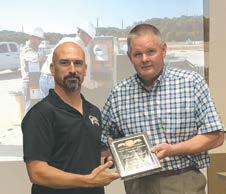












District Public Service Commissioner Chris Brown visited Pontotoc Electric Power Association in April to present a resolution for Lineworker Appreciation Day.



Pontotoc Electric Power Association celebrates our employees who have service anniversaries!
We appreciate their dedication to PEPA and our members.
25 Years

Tom Hill Purchasing Agent/Warehouseman
15 Years


35 Years

Mary Williamson Collections Manager

Harrelson Journeyman Lineman
10 Years




Richard Morgan Staking Technician
20 Years

John Ivy Journeyman Lineman

Wooten Journeyman Lineman






Clay Kidd
Apprentice Lineman

Sam Stewart
Apprentice Lineman





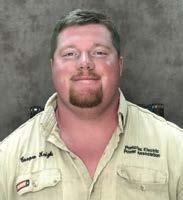


Rhianna McClellan









You can serve these cool treats without even turning on your oven. Enjoy these tasty recipes when the weather is warm. Your taste buds will thank you, and you could save energy too!















While June is the o cial beginning of hurricane season, our area has already experienced extreme weather events, with our neighbors to the north sustaining extensive damage from tornadoes. Just as Singing River Electric sent line crews to help in the restoration process, if we experience damage to our system, neighboring cooperatives will do the same for us. This is where our sixth cooperative principle – Cooperation Among Cooperatives – benefits our communities the most. Being part of a national network of electric cooperatives provides us with access to line personnel who will assist in restoring your electric service should we have a weather disaster.
Meteorologists are predicting the 2025 hurricane season, beginning June 1 and lasting through November 30, to have 17 named storms ranging from Andrea to Wendy. While most are looking forward to


kicking o the summer season, our team is busy preparing for the threats that go hand in hand with the warmer weather.
Singing River Electric conducted its annual review of the Emergency Preparedness Plan which contains detailed steps once a storm enters the gulf. Employees are pre-assigned tasks, such as securing supplies, fuel, food, and housing. We have activated and successfully implemented our ever-evolving plan countless times through the years.
Not to dampen your summer fun planning, but I encourage you to also have a plan in place for your family in case a storm threatens our area. In the coming weeks, you can prepare for hurricane season by making sure you have non-perishable food, water, and fuel, and have a storm evacuation route picked out ahead of time.
I encourage you to be proactive this hurricane season; it is never too early begin preparations. In the event of severe weather, your electric cooperative is prepared to restore electric service to our members as quickly and safely as possible.
by Brian Hughey





















Gabe Robbins
Energy Services Representative robbins@singingriver.com



The month of June not only brings longer days and warmer weather but also marks the o cial start of summer.
Take time to make sure your air conditioning unit is in tip-top shape. Scheduling a service call with your local technician will certainly result in energy savings. Changing your air filter regularly can ensure proper air flow throughout your HVAC (heating, ventilation, and air conditioning) system.
When it comes to using less energy in June and the summer months, I recommend these actions:
• Setting your thermostat to 78° F or as high as comfortably possible.
• Using fans to circulate air in rooms you are occupying.
• Sealing air leaks around windows and doors.
• Closing blinds and curtains during the day to block unwanted sunlight and heat.
• Monitoring your energy use with the SmartHub app. Download the app by visiting singingriver.com/smarthub.

Learn more about how your electric cooperative works and participate by voting in person in SRE’s board of directors election.
Our 87th Annual Membership Meeting will be held on June 26 at SRE’s Lucedale o ce located at 11187 Old 63 South. Registration begins at 5 p.m., and the meeting starts at 6 p.m.
The meeting will include an annual update on business of the cooperative, a report outlining 2024 financials, the board election, and more. All three districts will have an election for Post 1 board seats. Any Singing River Electric member may vote in person at the annual meeting on June 26. According to the bylaws, SRE members should vote for one candidate in each of the three districts. Members can also vote online or return their proxy by mail. Voting fulfills the 2nd Cooperative Principle – Democratic Member Control.
Each member is entitled to one vote regardless of the number of accounts in the person’s name. A proxy may be assigned to the board as a whole, or a member can vote up to 200 assigned proxies at the membership meeting. The presence of a member at the meeting or an online vote, or in the case of joint membership, the presence of a spouse shall revoke the proxy. All proxies must be received by SRE’s Lucedale o ce at close of business on June 17.
Members returning their proxy or voting online will be entered into a drawing for up to $500 cash. Those attending the annual meeting will be eligible for attendance prizes.




Candidates for one 3-year term by district:
Stanley R. Busby
Representing Greene, Perry and Wayne counties in Miss., and Washington County in Ala.
II, Post 1
Ronald Wilson
Representing George and Stone counties in Miss., and Mobile County in Ala.
Olin Howard Davis
Ryan Earley
1. Vote online by opening the SmartHub app or visiting www.singingriver.com and clicking on the “Vote Here” icon at the top of the page. By entering your membership ID and zip code, you can view candidate biographies and cast your vote by the Tuesday, June 17, deadline.
2. Vote by proxy by completing the mailed proxy and returning it using the enclosed self-addressed envelope by the Tuesday, June 17, deadline. The proxy allows the board of directors or another member to cast your vote. You may still attend the meeting; your presence will rescind the proxy allowing you to vote in person.
3. Vote in person at the Annual Membership Meeting on Thursday, June 26, at the Singing River Electric Lucedale o ce located at 11187 Old 63 South.
*Deadline to vote by SmartHub app/online or return your proxy is June 17.


Representing Jackson and Harrison counties in Miss.
Deadline for nominations to be placed on the ballot was Feb. 28, 2025. This deadline and a notice for nominations was included in the Jan. and Feb. 2025 Today in Mississippi magazine issues.
You can win up to $500 by voting online or returning your completed proxy by mail by June 17.












Represents SRE members in Greene, Perry and Wayne counties in Mississippi, and Washington County in Alabama.
Represents SRE members in George and Stone counties in Mississippi, and Mobile County in Alabama. Represents SRE members in Jackson and Harrison counties in Mississippi.



Whether you're streaming by the pool, working from home in the shade, or entertaining on the patio, everyone in your home can stay connected with a proper outdoor Wi-Fi setup – and get the same amazing speed and reliability!

Even boost the Wi-Fi signal for your security cameras, doorbells, outdoor lights, and nearby workshops and secondary structures.
With our Speed Fanatic package (2 Gig), Singing River Electric technicians will help design and equip your outdoor space for Wi-Fi.

JUNE 2025
Step 3: Fiber Construction
Running fiber lines on poles and burying lines underground
• Bayou Cassotte
• Kreole
• Monaco Lake
• Singing River Mall
• Gautier
Step 4: Splicing
• Fountainbleu
• Hamill Farm
• Ocean Springs
• Gulf Park Estates
Connecting fiber lines to the network
• Sunplex
Step 5: Service Drop & Drop
Splicing & Step 6: Installation
Bringing mainline fiber to the exterior of your home and connecting your home to blazing-fast fiber internet
• Fort Bayou
• Martin Blu
• Hickory Hills
• St. Martin
• Tucker Road
• Forts Lake
• Helena
• Helena Industrial
• Escatawpa South
• All Singing River Electric areas in George, Greene, Perry, Stone, Wayne, Harrison, Mobile, and Washington counties and north Jackson County




Singing River Electric linemen work daily on projects to benefit our members. Whether running service to a new home or business or upgrading existing lines and equipment, our linemen are skilled at getting the job done safely and efficiently.
Left: Linemen from our Sand Hill and Lucedale o ces were recently in Perry County's Arlington community performing a voltage conversion – the final step of transferring this power load from the McLain substation to the Hintonville substation. By planning and executing projects like this, Singing River Electric provides greater reliability for members and supports future growth.
Right: Gautier linemen ran underground service for a new apartment complex on Jackson County’s Mallett Road. Along the coast, housing developments with underground power requirements are booming, and using an underground pulling machine allows our linemen to significantly reduce construction time.
During periods of extreme heat, the demand for electricity can skyrocket, placing additional strain on our system. By working together to lower our electricity use, we can reduce pressure on the grid.
Here are five effective ways to lower energy use at home.


1. Raise your thermostat setting a few degrees higher than usual. Every degree can reduce energy consumption and cooling costs.
2. Cook with smaller appliances to save energy and reduce heat gain in the kitchen.























3. Keep blinds, curtains, and shades closed during the hottest part of the day to block direct sunlight.
4. Use fans to circulate air, which can make you feel cooler without needing to lower the thermostat.
5. Shift activities that require a lot of energy use, like washing clothes and running your dishwasher, to mornings or evenings when demand is lower.








At Southern Pine Electric, we’re always looking for ways to make life a little easier for our members. Because we serve such a large geographic area, we understand that getting to one of our fi ve district o ces isn’t always the most convenient option when it’s time to pay your electric bill.
That’s why we’ve added a new, easy way to pay — CheckOut by PayGo. This cash-only option lets you pay your Southern Pine bill at many of the places you already shop, including Dollar General, Family Dollar, Walgreens, and CVS Pharmacy. You don’t need to make a special trip. Just bring your bill with you, tell the cashier how much you want to pay, and they’ll take care of the rest.
HERE’S HOW IT WORKS:
1. Get Your Barcode. Before you head out grab your Southern Pine bill with the unique barcode printed on the back or visit southernpine.meridiancheckout.com/Lookup to generate your personal barcode. All you need is your account information.
2. Look Up Locations. That same website also lets you fi nd nearby participating stores.
It’s simple, secure, and convenient. Whether you’re picking up groceries, running errands, or grabbing a prescription, you now have another easy way to keep your account current — on your schedule.

3. Make Your Payment. Once you’re at the store, show your barcode (either printed or on your phone), and pay the amount you’d like using cash. The store will charge a $1.50 convenience fee, and your payment will be applied to your account automatically — usually within minutes.

At Southern Pine, we’re committed to providing not just reliable electricity, but reliable service in every sense of the word. That means more options, more convenience, and more ways to serve you, our members.
Thank you for the trust you place in us every day.

by Chris K. Rhodes
President/CEO Southern Pine Electric

Only cash payments can be made at these locations. A convenience fee of $1.50 will be charged by the store.










At Southern Pine Electric, we believe that strong communities are built on service, compassion, and a willingness to help others. Every day, we see young people stepping up to make a di erence — volunteering their time, talents, and energy to serve their friends and neighbors. That’s why we’re excited to announce a new program: Young Members in Action.
Young Members in Action is designed to recognize and spotlight outstanding young individuals and groups who are making a positive impact in the communities we serve. Each month, we will feature a student or group of students who have gone above and beyond through volunteer work, service projects, or acts of kindness. Their stories will be shared on Southern Pine Electric’s social media accounts, so that everyone can celebrate their e orts.
Whether it’s organizing a food drive, cleaning up a park, mentoring younger students, or assisting the elderly, we want to shine a light on the good things young people are doing across our service area. These young leaders are setting an incredible example, and we are proud to help tell their stories.
If you know a student — or a group of students — who deserves to be recognized, we encourage you to nominate them! Any Southern Pine Electric member can submit a nomination by visiting southernpine.coop/youngmembers. It’s quick and easy. Simply tell us about their volunteer work and how they’re making a di erence. Photos are welcome too!
Together, let’s celebrate the young members who are making our communities stronger, one good deed at a time. Nominate a young hero today!














Each year, as summer settles in, so does hurricane season — and in Mississippi, it’s important to be prepared. At Southern Pine Electric, your safety is always our top priority. While we work hard year-round to strengthen our system against storms, hurricanes and tropical storms can still cause major damage, leading to power outages and dangerous conditions. Now is the time to get your family, home, and property ready. A little preparation today can make a big di erence if a storm heads our way.
• Talk with your family about where to go and what to do if a hurricane threatens your area.
• Plan for pets — Many shelters won’t accept them, so make arrangements ahead of time.
• Know your evacuation route and have a list of nearby shelters.
• Sign up for local alerts to get real-time updates.
Having the right supplies on hand can help you ride out a storm more safely and comfortably. Your emergency kit should include
• Flashlights and extra batteries,
• Non-perishable food and bottled water (enough for at least three days),
• First aid supplies and necessary medications,
• Cell phone chargers (including a backup battery or solar charger),
• Important documents stored in a waterproof container, and
• Cash — ATMs and card readers may not work during outages.

• Trim trees and branches away from your home and power lines to reduce damage.
• Secure outdoor items like patio furniture, grills, and decorations.
• Check your generator if you have one. Make sure it’s working properly and that you know how to operate it safely.
• Stock up early — Waiting until a storm is on the way can leave you with empty shelves and long lines.
Despite our best e orts, hurricanes can cause widespread outages. Here’s how to stay safe and prepared:
• Stay away from downed power lines and anything touching them. Always assume lines are live.
• Report outages to Southern Pine Electric by text, through our MyPower app, or by calling 1-800-231-5240.
• Turn o major appliances like air conditioners until power is fully restored to avoid a sudden surge when electricity comes back.
• Use generators safely — Never operate them indoors or in enclosed spaces. Keep them well away from windows and doors.

Even after a hurricane passes, dangers can remain. Watch for debris, damaged power lines, and flooded areas. If your home is damaged, it may need to be inspected by a qualified electrician before it can safely receive power again.
At Southern Pine Electric, we prepare all year long to respond quickly when storms hit, and we’re proud to serve you in every season. By taking a few simple steps now, you can help protect your family and make recovery easier if disaster strikes.
Stay safe, stay ready — and know that when the winds blow, we’ll be here for you.





























When outdoor temperatures soar, our electricity use increases. That’s because our air conditioners are running longer and more often to counteract sweltering outdoor temperatures. Factor in that we all tend to use electricity at the same times — in the morning and early evenings — and that equals a lot of strain on our electric grid.
At Southern Pine Electric, we work closely with Cooperative Energy our local generation and transmission (G&T) cooperative in resource and infrastructure planning to ensure you have the power you need whenever you flip a switch, but the electric grid is much larger than your local co-op and G&T.
In summer months, when even more electricity is being used




simultaneously across the country, it is possible for electricity demand to exceed supply, especially if a prolonged heat wave occurs. If this happens, which is rare, the grid operator for our region of the country may call on consumers to actively reduce their energy use or initiate rolling power outages to relieve pressure on the grid. Southern Pine Electric will always keep you informed about situations like this.
We work proactively with our G&T to create a resilient portion of the grid and ensure electric reliability in extreme weather, including regular system maintenance, grid modernization e orts, and disaster response planning, but it takes everyone to keep the grid reliable.
To help keep the air conditioner running for you, your family and neighbors, here are a few things you can do to relieve pressure on the grid during times of extreme summer heat:
• Select the highest comfortable thermostat setting and turn it up several degrees whenever possible. Your cooling system must run longer to make up the di erence between the thermostat temp and the outdoor temp.
– Pro tip: Seal air leaks around windows and exterior doors with caulk and weatherstripping. Air leaks and drafts force your cooling system to work harder than necessary.
• Use ceiling fans to make yourself feel a few degrees cooler. Remember, ceiling fans cool people (not rooms), so turn them o in unoccupied rooms.
– Pro tip: During summer months, set ceiling fan blades to rotate counterclockwise, which pushes cool air down for a windchill e ect.
• Run major appliances, such as dishwashers, ovens, and dryers, during o -peak hours when the demand for electricity is lower.
– Pro tip: Start the dishwasher before you go to bed.
• Close blinds, curtains and shades during the hottest part of the day to block unwanted heat gain from sunlight.
– Pro tip: Consider blackout curtains with thermal backing or reflective lining to block heat and light.
• Use smaller appliances, such as slow cookers, air fryers, and toaster ovens, to cook meals.
– Pro tip: Studies have shown that air fryers use about half the amount of electricity than a full-sized oven. Air fryers are smaller and use focused heat, which results in faster cooking times, less heat output, and lower energy use.


As we face the challenges posed by soaring summer temperatures, understanding the impact on energy demand is crucial for maintaining a reliable power supply. By adopting energy conservation practices during periods of extreme heat, not only can you save money on your electric bills, but you can also contribute to the resilience of the grid, keeping our local community cool and connected.
























































WEDNESDAY, AUGUST 13, AT 10 A.M.
Southwest Electric’s bylaws can be found at southwestelectric.coop/what-is-a-cooperative or by scanning the QR code. The Nondiscrimination Statement can be found at southwestelectric.coop/nondiscrimination-statement or by scanning the QR code.















Don’t forget any special family needs such as small children, medical equipment and pets. Know your evacuation route and shelter plan. Visit ready.gov/plan for printable plans.



As we approach another active hurricane season in 2025, now is the time to Make a Plan, Build a Kit, and Be Informed in the event of bad weather. We can’t control the weather, but we can prepare for its impact.


Make sure you have enough food, water, medical supplies, prescriptions, cash and special food and supplies for children and pets. A comprehensive list is available at ready.gov/kit.

Consider purchasing a weather radio and extra batteries. Set your phone to receive emergency notifications. Download the apps from MEMA (Mississippi Emergency Management Agency) and FEMA (Federal Emergency Management Agency).




“Anyone can be a father, but it takes someone special to be a dad, and that’s why I call you dad, because you are so special to me. You taught me the game, and you taught me how to play it right.” – Wade Boggs, MLB third baseman















We invite the public to join us in Lorman to donate blood.






by Scott Flood
When linemen are perched in a bucket truck, repairing power lines along a busy road, they have good reason to be concerned about their safety. However, most are less apprehensive about problems like working with high voltages or falling. Their biggest worry is also the most unpredictable: a distracted driver slamming into their vehicle or a nearby power pole.
The National Safety Council reported that 891 people were killed and 37,701 people were injured in work zone crashes during 2022 (the most recent statistics). Most of those crashes occur in construction sites, which are usually well-marked. Electric cooperative crews are likely to face even greater danger, as they are often working alone along remote stretches of roads, frequently in heavy rain or other adverse weather conditions that can reduce their visibility.
The danger of work zone crashes led every state to adopt “move over” laws that require drivers to lower their speed and switch lanes when possible to protect emergency vehicles. The goal is to provide an added safety bu er and minimize the potential for accidents. Drivers caught violating the laws can face penalties such as significant fines.
Compounding this issue is the dramatic increase in distracted driving. The National Transportation Highway Safety Administration has reported that as many as 1,000 Americans are injured each day because of activities that take drivers’ attention away from the road. The most common is reading and responding to text messages. If a driver traveling at 55 miles per hour glances at their phone for just five seconds, they’ll have traveled the length of a football field before returning their gaze to the road.
The design of today’s vehicles contributes to distraction. Many vehicles have complex controls for entertainment and climate that demand the driver take their eyes o the road to make even simple adjustments.
Geography can also be a factor. Cooperatives serving rural and remote areas often have power lines along twisty and hilly roads. Locals accustomed to driving those roads at fairly high speeds may be startled and have little time to react when they encounter a work crew past a hill or around a curve.
Besides the potential for lineman injuries, accidents can also damage or destroy expensive service vehicles, reducing a cooperative’s ability to respond to outages and other problems. Power poles and other infrastructure may also su er severe damage.
Additionally, many of the tasks performed by linemen, such as reconnecting high-voltage power lines, are inherently dangerous and require their complete focus. When their attention is distracted by speeding or noisy vehicles, they’re more likely to make mistakes that can complicate the repair or cause injury.
Nor are cooperative employees at risk only when their vehicles are parked and repairs are underway. Linemen frequently have to drive slowly along the shoulder of roads to pinpoint broken power lines or failed transformers, especially in darkness or conditions that interfere with visibility.




Many state transportation agencies have work zone awareness programs. Amplifying those e orts by devoting part of a cooperative’s advertising, publicity, and social media reminds cooperative members and other drivers of the importance of giving linemen a wide berth.
Cooperatives are considering ways they can modify bucket trucks and other service vehicles to make them more visible. Bright colors and additional lighting such as flashing strobe lights and lighted detour arrows can attract attention from a distance. Reflective “work zone ahead” signs can also alert drivers to be ready for an unusual situation. Sometimes, a little bit of extra attention is all that’s needed to prevent a serious incident.
For more than four decades, business writer Scott Flood has worked with electric cooperatives to build knowledge of energy-related issues among directors, sta and members.



Mississippi’s “Move Over” law was passed to safeguard law enforcement, fire, highway construction workers and utility crews and vehicles.
According to the law, motorists passing a utility vehicle must slow down and yield the right-of-way by changing lanes, keeping at least one empty lane where possible. If a lane change is impossible, a driver must slow down and be prepared to stop.
Violators may be fined up to $250 for failing to comply and up to $1,000 if there is damage to the o cial vehicle or injury to any driver or passenger of an o cial vehicle.































TOOLS NEEDED
Garden hose with spray nozzle
Fin comb (optional, for bent fins)







helps it run more e ciently and can extend its lifespan.




Screwdriver or 5/16 nut driver (if needed to remove fan top)
Soft brush or vacuum with brush attachment
Coil cleaner (non-acidic, available at hardware stores)
Gloves and eye protection
JULY 4, 2025



Our o ces will be closed on Friday, July 4, in observance of Independence Day. Dispatchers will remain on duty and crews will be on call throughout the holiday.
Use the SmartHub app, text ‘OUT’ to 844-975-2728 or call 800-287-8564 to report an outage.

HERE’S A STEP-BY-STEP GUIDE:
• Turn OFF power.




• Switch o the AC unit at the breaker box and the outside disconnect box near the condenser.
• Clear debris.
• Remove leaves, twigs and other debris from around the unit. Trim back vegetation at least 2 feet away.
• Remove the top grille.
• Use a screwdriver or 5/16 nut driver to remove the top cover (usually where the fan is located). Carefully lift it - note the fan may be attached.
• Clean inside the unit.
• Vacuum or brush out any debris inside the unit carefully, especially near the bottom.
• Straighten bent fins and coils (optional).
• Use a fin comb or butter knife gently to straighten any bent fins.
• Spray the fins and coils.
• Spray coil cleaner on the fins and let it sit per instructions (usually 5-10 minutes).
• Clean the fan blades.
• Wipe down the fan blades with a damp cloth while the top is o .
• Reassemble and restore power.
• Reattach the fan/grille, ensure everything is secure and turn power back on.
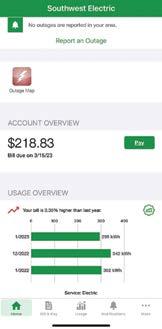


Download the SmartHub app from iTunes in the Apple App Store or in the Android Marketplace by searching for “SmartHub.” To log in on your computer, visit southwestelectric.coop/smarthub/ and click on Manage My Account.
Need help downloading the app or using a feature? Contact our Member Services Department at 800-287-8564 or visit our website at southwestelectric.coop/ smarthub/ for “How To” videos.














































When outdoor temperatures soar, our electricity use increases. That’s because our air conditioners are running longer and more often to counteract sweltering outdoor temperatures. Factor in that we all tend to use electricity at the same times — in the morning and early evenings — and that equals a lot of strain on our electric grid.
At Tippah EPA, we work closely with the Tennessee Valley Authority (TVA), our local generation and transmission cooperative in resource and infrastructure planning to ensure you have the power you need whenever you flip a switch, but the electric grid is much larger than Tippah and TVA.
To help keep the air conditioner running for you, your family and neighbors, here are a few things you can do to relieve pressure on the grid during times of extreme summer heat:
• Select the highest comfortable thermostat setting and turn it up several degrees whenever possible. Your cooling system must run longer to make up the di erence between the thermostat temp and the outdoor temp.
– Pro tip: Seal air leaks around windows and exterior doors with caulk and weatherstripping. Air leaks and drafts force your cooling system to work harder than necessary.
• Run major appliances, such as dishwashers, ovens, and dryers, during o -peak hours when the demand for electricity is lower.
– Pro tip: Start the dishwasher before you go to bed.







In summer months, when even more electricity is being used simultaneously across the country, it is possible for electricity demand to exceed supply, especially if a prolonged heat wave occurs. If this happens, which is rare, the grid operator for our region of the country may call on consumers to actively reduce their energy use or initiate rolling power outages to relieve pressure on the grid. Tippah EPA will always keep you informed about situations like this. We work proactively with TVA to create a resilient portion of the grid and ensure electric reliability in extreme weather, including regular system maintenance, grid modernization e orts, and disaster response planning, but it takes everyone to keep the grid reliable.

As we face the challenges posed by soaring summer temperatures, understanding the impact on energy demand is crucial for maintaining a reliable power supply. By adopting energy conservation practices during periods of extreme heat, not only can you save money on your electric bills, but you can also contribute to the resilience of the grid, keeping our local community cool and connected.
• Use ceiling fans to make yourself feel a few degrees cooler. Remember, ceiling fans cool people (not rooms), so turn them o in unoccupied rooms.
– Pro tip: During summer months, set ceiling fan blades to rotate counterclockwise, which pushes cool air down for a windchill e ect.
• Close blinds, curtains and shades during the hottest part of the day to block unwanted heat gain from sunlight.
– Pro tip: Consider blackout curtains with thermal backing or reflective lining to block heat and light.
• Use smaller appliances, such as slow cookers, air fryers, and toaster ovens, to cook meals.
– Pro tip: Studies have shown that air fryers use about half the amount of electricity than a full-sized oven. Air fryers are smaller and use focused heat, which results in faster cooking times, less heat output, and lower energy use.

by Tim Smith General Manager
Each director is automatically a candidate for re-election unless the Director notifies the Secretary of the Corporation otherwise at least twenty-five (25) days before the annual meeting of the members. Any member of the Corporation who meets the qualifications set forth in these By-Laws may qualify by petition to become a candidate for Director. Petitions may be picked up at Tippah Electric Office the first business day of September. Petitions must be picked up from the Tippah Electric Office no later than the last business day of September. This petition must be in a form provided by the Corporation and shall contain a request signed by the member stating his/her desire to become a candidate for Director of The Tippah Electric Power Association. The petition shall also indicate the area for which the member desired to be a candidate and must contain the endorsement of not less than twenty-five (25) active members that live in the area from which he/ she is to be a candidate for Director. Falsification of information on the petition shall result in the petition being invalidated. The petition must be submitted and received by the Secretary of the Corporation or his/her designee no later than 5:00 p.m. on the second Thursday of each October. Individual petitions must be filed by each member desiring to qualify as a candidate for Director.
All members shall be entitled to vote on all Directors to be elected, regardless of the area such Directors are to represent. A duly completed ballot shall constitute the sole and exclusive means of voting for candidates for Director. The use of proxies or in-person voting is not permitted in Director elections. Ballots shall be in a form approved by the Corporation’s Board.
Ballots shall be mailed to all members of the Corporation no later than the 1st Monday of November. Completed ballots must be returned by U. S. mail to the address specified by the Board and must be received at such address no later than the third Monday of each November in order to be counted. The Board in its discretion shall retain an independent entity to obtain and compile ballots, to count ballots, to assist with determining eligibility of members to vote and to certify election results. Only votes from members who are active as of 5:00 p.m. on September 30th, shall be counted. If an active member states that they didn’t initially receive a mail out ballot, then they have the option to receive a replacement ballot only 1 time. They will be responsible for picking up a replacement ballot at TEPA’s office. Each replacement ballot will be randomly numbered to monitor which ballots are received or if they have been duplicated.
In order to win any election for Director, a candidate must receive a majority (i.e., fifty percent of the total qualified vote plus one) to win. Should a winner not be declared in a Director election due to the failure of any candidate to receive a majority of qualified votes, the two candidates with the highest number of qualified votes shall be in a run-off election. The candidate with the highest number of qualified votes in a run-off election shall be declared the winner. A run-off election, if necessary, shall be conducted as soon as possible after the initial election results are certified.
In order for a valid election for Directors to be held, ballots must be received from a minimum of ten percent (10%) of the Corporation’s active members determined as of September 30th of each election year. In the event that this minimum number of votes is not received, the present Directors shall continue to serve as Directors for another term, and any vacancy shall be filled by the Board, subject to the provisions of these Bylaws with respect to Directors. For a run-off election, no minimum number of ballots must be received in order to declare a winner.
If a sitting Director is unopposed in any election year when he/she is running for reelection, that Director shall automatically be approved by the Board for an additional three (3) year term. In any such case where a sitting Director is unopposed for re-election, no election will be held for that particular Area for that specific three (3) year term.
If a sitting Director’s name is withdrawn from an election for any reason (including but not limited to that Director’s death) after that Director has qualified as a candidate pursuant to Article V, Section 3, in a situation where there is only one other candidate for that specific Director seat the Board shall establish a special qualifying period for other potential candidates to qualify for this position. The length of any special qualifying period shall be determined by the Board, in its sole discretion. The Board may determine, in its sole discretion, to hold a special election for this specific Director position.
In order to become or remain a member of the Board of Directors of the Corporation, a person:
1. Must be an individual with the capacity to enter into legally binding contracts.
2. Must be a member in good standing on all Tippah Electric accounts in that member’s name, for at least 12 months prior to the qualifying date of the year such individual would run for Board membership.
3. Member may only qualify to run for director in the area of his bona fide residency Membership and residency must be in the area represented and Account and Membership must be in the candidate’s name for 12 months prior to seeking nomination at said residence.
4. Must not be employed by or in any way financially interested in a competing enterprise or a business selling electric energy supplies, or services, to the Corporation.
5. Must not have been an employee of the Corporation within five (5) years prior to the beginning of the term.
6. Must not have a spouse, child, sibling or parent who has been an employee of the Corporation within five (5) years prior to the beginning of the term.
7. Must not hold an elected public office at the time a petition is submitted by the candidate.
8. Must not have been convicted or have plead guilty to a felony.
9. Must comply with any other reasonable qualifications determined by the Board.
10. Must not be an employee of or a member of any union representing any number of employees of the Association.
In the event a membership is held jointly by husband and wife, either one, but not both, may be elected a director, PROVIDED, that neither one shall be eligible to become or remain a director unless both shall meet the qualifications hereinabove set forth.
You may qualify for federal assistance, making your phone and internet more a ordable.
Lifeline is a federal program dedicated to making phone and internet service more a ordable for low-income households. This benefit provides eligible consumers with a monthly discount of up to $9.25. Check online at https://www.lifelinesupport.org/get-started to see if you qualify.
If you have any questions about these programs, please call the TEPAConnect office at 662-587-9055.









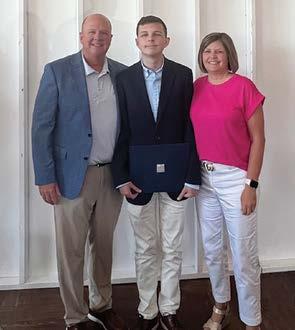






Gavin Smith, valedictorian of the 2025 graduating class of Kossuth High School, has been chosen to receive the 2025 Power Play Scholarship. This scholarship is provided by the Tennessee Valley Authority (TVA) and local power companies who award them to graduates who are dependent children of a power distributor employee. Gavin is the son of Tippah EPA General Manager Tim Smith and his wife Vicki of Ripley.
The recipients of the TVA scholarships must show leadership by investing their time and talent in community development, personal growth, and team accomplishments.
Gavin’s interests and achievements while in school consist of the National Honor Society, National Technical Honor Society, FBLA, Rotary Student of the Month, Top Ten Academics, a Community Connections mentor, STAR student, and is a member of the ACT 29+ Club.
Gavin plans to attend Mississippi State University in the fall to pursue a degree in aerospace engineering. He has been accepted into the Shackouls Honor College and the Bagley College of Engineering.
Congratulations, Gavin!
Pictured: Tippah General Manager Tim Smith, Gavin Smith, and Vicki Smith.


















SERVING MORE THAN 12,600 ELECTRIC METERS IN SEVEN DELTA COUNTIES




Hollandale - 662-827-2262 | Belzoni - 662-247-1909 | Greenville - 662-334-9543 | Rolling Fork - 662-873-4233 | REPORT OUTAGES 866-897-7250 @twincoepa twincoepa.com
Twin County EPA celebrated linemen with a red-carpet arrival to kick o national Lineman Appreciation Day on April 18.
The sta joined them for lunch followed by an action-packed video, and a wonderful message from General Manager Leslie Holloway, reminding everyone that linemen’s unwavering dedication and commitment are the backbone of our organization.
“We deeply value your hard work and the exceptional service you provide to our members. Your contributions make a significant di erence, and we are grateful for everything you do,” Holloway said.
Holloway concluded the event by leading everyone in the “Lineman Prayer.”
Photos were taken at each Twin County branch. Twin County was honored to have Central District Public Service Commissioner DeKeither Stamps attend the event.















Twin County EPA is proud to partner with and support the Mississippi Delta Community College /CAPPS Center’s Lineman Program. Twin County sta coached and judged the school’s Lineman Rodeo.
Congratulations to MDCC Lineman Class No. 30.






years of Dolly Parton’s
Twin County EPA is proud to participate locally in Dolly Parton’s book gifting program that mails free, high-quality books to children from birth to five years of age.




Our inaugural campaign kicked-o last year with “Dunking Booth for Dolly.”















QWhat are some energy e ciency upgrades I should consider when building a new house?



APrioritizing energy e ciency when building a new home can create future savings and make living more comfortable. It might cost a little more upfront but will pay o in the long run.


by Miranda Boutelle

Let’s explore two approaches: Following an energy e ciency certification plan or adding energy e cient designs and equipment to your construction project.
There are several e ciency certifications available for new-construction homes that may qualify for discounted homeowner’s insurance, tax credits, and other incentives.
Leadership in Energy and Environmental Design (LEED) certification ensures the home uses less energy while prioritizing sustainable resources and healthy indoor air quality. LEED-certified homes use 20% to 30% less energy than the average home — with some homes saving up to 60% — and can cost the same as non-LEED homes with proper planning, according to the U.S. Green Building Council.


Passive House certification requires the home to be so e cient it needs little to no heating and cooling equipment while remaining comfortable for its occupants. To achieve up to 90% less energy use than the average home, the certification focuses on maximizing the e ciency of the building envelope — all components that separate the indoors from the outdoors — including proper insulation levels, air sealing and high-e ciency windows.
ENERGY STAR® NextGen Certification for New Homes recognizes houses that are 20% more e cient than the average home and help reduce greenhouse gas emissions by 40% to 80%.
Although various certifications are available, you don’t have to follow a set guide. Consider adding these energy e ciency principles to your new home build.





Advanced framing techniques maximize the amount of insulated area and save on material costs in woodframed homes. This technique can save up to $500 for a 1,200-square-foot home and $1,000 for a 2,400square-foot home on material costs, between 3% to 5% on labor costs and up to 5% on annual heating and cooling costs, according to the U.S. Department of Energy. Choose a contractor who is familiar with these techniques, and check with your local building o cials to ensure compliance with local codes.
The importance of a home’s orientation is often overlooked. According to the International Association of Certified Home Inspectors, homes oriented to the path of the sun use less energy for heating and cooling to reduce energy bills and improve comfort.
Advanced framing techniques maximize the amount of insulated area and save on material costs in wood-framed homes. This technique can save up to $500 for a 1,200-square-foot home and $1,000 for a 2,400-square-foot home on material costs.
If you are building or buying a new home that doesn’t allow options for orientation or framing, you might be able to request higher insulation levels in the attic. Increasing the insulation levels likely won’t cost much more for materials and labor, but it can help you use less energy and save money in the long run.
Heating and cooling equipment should be properly sized using energy modeling tools that calculate the home’s heating and cooling needs. Investing in a more e cient building envelope that is well insulated and air sealed can reduce the home’s heating and cooling load, making it possible to have a smaller, less expensive heating and cooling system. This saves money on equipment costs and lowers energy use.
Optimizing the e ciency of a new home requires a whole-house approach. Analyze all systems and how they work together to ensure maximum e ciency for a safe and comfortable home.
Miranda Boutelle is the chief operating o cer at E ciency Services Group in Oregon, a cooperatively owned energy e ciency company.






















by Michael Leitman
Providing members with safe, reliable, and a ordable power is the mantra for electric cooperatives across the nation. Co-op members can see the work necessary to maintain reliable electricity at the local level, such as co-op lineworkers maintaining utility poles and wires and repairing them after major storms. At the regional and national levels, a diverse mix of power generation resources, transmission lines, and pipeline infrastructure are essential cornerstones of maintaining reliable electricity.
The U.S. electric grid has undergone major changes over the last decade. The share of electricity generated from coal plants has declined significantly, while the share from natural gas and intermittent wind and solar generation has grown. Fuel diversity means that your electricity is supplied by a variety of generation technologies, each with their own characteristics and performance capabilities over di erent weather and seasonal conditions.
Dispatchable technologies can be turned on and o as needed. Large steam generation plants (most commonly using coal or nuclear fuels) are generally considered “baseload,” meaning that they are designed to run e ciently 24/7 to serve as the base of the electricity mix. However, steam plants are less capable of ramping output up or down to meet the various peaks and dips as grid conditions change.
Natural gas is the most versatile fuel, powering large combinedcycle plants that can operate as baseload but are also more flexible ramping up and down. These capabilities are essential for meeting demand on the hottest and coldest days, and for balancing intermittent renewable energy sources, such as solar and wind.
Most hydroelectric power comes from generators inside large dams, which can be dispatched when needed — as long as there is enough water available. Cooperative Energy, a Mississippi generation and transmission cooperative, has several contracts to buy hydroelectric power from the Southeastern Power Administration.
Over the last decade, the share of electricity generated from wind and solar plants has increased dramatically. These beneficial, “no-fuel-required” plants can deliver low-cost electricity — but they only generate electricity when the wind blows and the sun shines. The production patterns of solar and wind technologies are complimentary to one another. Solar generates during the day and wind tends to generate more at night. Across seasons, wind output is typically higher during the colder months when there is less sunshine. Deployed together, wind and solar technologies can balance each other. Although there is a limited availability of wind power in Mississippi, there is a small amount that supplements power in the state from The Midcontinent Independent System Operation (MISO), a regional power reliability group that counts the state as a member.
















While battery energy storage technology is growing rapidly to allow some control of when renewable energy sources can be dispatched, natural gas plants remain the primary method for “firming” renewable generation resources.
Ultimately, our electric grid is most reliable when a wide range of technologies is available. When conditions lead to lower generation from one type of source, others can help compensate. When there is an imbalance, such as a major winter storm when electricity use skyrockets, grid operators are forced to rely on purposefully reducing demand and occasionally plan rolling blackouts to keep the grid operating.
While there is variation across regions in what types of power plants can be built based on weather and infrastructure, America’s electric cooperatives work diligently to ensure a diverse and reliable power supply for the communities they serve.

Our electric grid is most reliable when a wide range of technologies, including traditional and renewable energy sources, is available.















































QWhat are some energy e ciency upgrades I should consider when building a new house?



APrioritizing energy e ciency when building a new home can create future savings and make living more comfortable. It might cost a little more upfront but will pay o in the long run.


by Miranda Boutelle

Let’s explore two approaches: Following an energy e ciency certification plan or adding energy e cient designs and equipment to your construction project.
There are several e ciency certifications available for new-construction homes that may qualify for discounted homeowner’s insurance, tax credits, and other incentives.
Leadership in Energy and Environmental Design (LEED) certification ensures the home uses less energy while prioritizing sustainable resources and healthy indoor air quality. LEED-certified homes use 20% to 30% less energy than the average home — with some homes saving up to 60% — and can cost the same as non-LEED homes with proper planning, according to the U.S. Green Building Council.


Passive House certification requires the home to be so e cient it needs little to no heating and cooling equipment while remaining comfortable for its occupants. To achieve up to 90% less energy use than the average home, the certification focuses on maximizing the e ciency of the building envelope — all components that separate the indoors from the outdoors — including proper insulation levels, air sealing and high-e ciency windows.
ENERGY STAR® NextGen Certification for New Homes recognizes houses that are 20% more e cient than the average home and help reduce greenhouse gas emissions by 40% to 80%.
Although various certifications are available, you don’t have to follow a set guide. Consider adding these energy e ciency principles to your new home build.
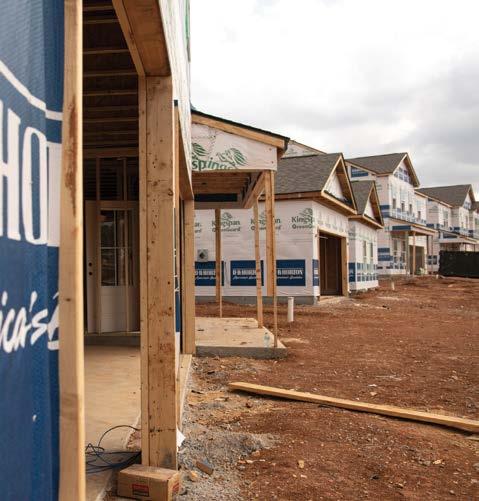




Advanced framing techniques maximize the amount of insulated area and save on material costs in woodframed homes. This technique can save up to $500 for a 1,200-square-foot home and $1,000 for a 2,400square-foot home on material costs, between 3% to 5% on labor costs and up to 5% on annual heating and cooling costs, according to the U.S. Department of Energy. Choose a contractor who is familiar with these techniques, and check with your local building o cials to ensure compliance with local codes.
The importance of a home’s orientation is often overlooked. According to the International Association of Certified Home Inspectors, homes oriented to the path of the sun use less energy for heating and cooling to reduce energy bills and improve comfort.
Advanced framing techniques maximize the amount of insulated area and save on material costs in wood-framed homes. This technique can save up to $500 for a 1,200-square-foot home and $1,000 for a 2,400-square-foot home on material costs.
If you are building or buying a new home that doesn’t allow options for orientation or framing, you might be able to request higher insulation levels in the attic. Increasing the insulation levels likely won’t cost much more for materials and labor, but it can help you use less energy and save money in the long run.
Heating and cooling equipment should be properly sized using energy modeling tools that calculate the home’s heating and cooling needs. Investing in a more e cient building envelope that is well insulated and air sealed can reduce the home’s heating and cooling load, making it possible to have a smaller, less expensive heating and cooling system. This saves money on equipment costs and lowers energy use.
Optimizing the e ciency of a new home requires a whole-house approach. Analyze all systems and how they work together to ensure maximum e ciency for a safe and comfortable home.
Miranda Boutelle is the chief operating o cer at E ciency Services Group in Oregon, a cooperatively owned energy e ciency company.



























A. Yazoo Valley’s Jose Solano raises a new American flag over downtown Yazoo City. Yazoo Valley partnered with the local VFW chapter to repair the flag pole and purchase the flag. B. Colton Collins checks out one of Yazoo Valley’s bucket trucks during a Touch A Truck event hosted by Yazoo City Junior Auxiliary. C. Benton Academy senior Avery Alexander was recognized during Awards Day by Yazoo Valley for successfully completing the Cooperative Youth Leaders Program. She is pictured with Member Services Manager Jason Patterson. D. Manchester Academy seniors Adalai Boggan and Annabeth Merrell were recognized during Awards Day by Yazoo Valley for successfully completing the Cooperative Youth Leaders Program. They are pictured with Member Services Manager Jason Patterson. E. Johnathon Demita throws a pass to a young athlete while volunteering with the Wil Saxton Football Camp at Benton Academy.






















The June 2025 magazine you are holding in your hand (or reading online) is our second food issue.
While our first foray into Mississippi’s cuisine last year was a deep dive into fried chicken, this year we went a little further. Fried chicken is just one of the many hot goodies to be found at a gas station.
Forget our friends up north. Down south, we love gas station food. I’m guessing most of us won’t make any apologies for that.
For years, gasoline hasn’t been the only fuel we need when we stop at a service station.
We reached out to our local electric cooperatives around the state and asked them to tell us about their favorite gas station food and where to find it in or near their territories.
We feature a few of those choices in our cover story and provide a list of the others they told us about to give you a handy statewide guide.
An issue like this is nice to have in your vehicle’s glove compartment for those times you find yourself somewhere in Mississippi other than your home base.
From ribeye angus steak and salads to peanut butter pie, these gas stations serve just about anything you might be craving.
Mississippi is many things.
Food is one of those many things the state is known for, so a magazine piece devoted to gas station cuisine made a lot of sense to us.
Hope you find your favorite gas station food after delving into the June issue.
Enjoy and bon appetit!

by Michael Callahan
Executive Vice President/CEO Electric Cooperatives of Mississippi





Pink streaks of clouds that color the evening sky.
Flocks of wood ducks flying by, Silhouettes of cypress and pine trees, as the sun dips below.
Their limbs stretching out in the final glow
Twilight arrives, dimming the view.
Except for the twinkling of Venus rising on cue.
The crickets sing a lullaby, bidding us goodnight.
Winding down this happy hour with all its glorious sights. by Holly Huye, a resident of Picayune, and a member of Coast Electric
What’s Mississippi to you? What do you treasure most about life in our state? Send your brief thoughts to Today in Mississippi, news@ecm.coop or mail to P.O. Box 3300, Ridgeland, MS 39158.
Submit your beautiful digital photo of life in Mississippi to Today in Mississippi, news@ecm.coop












































































